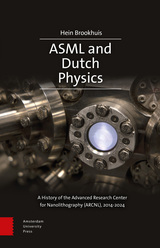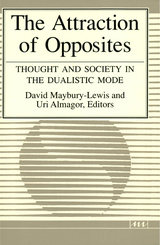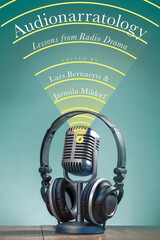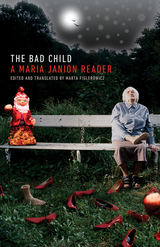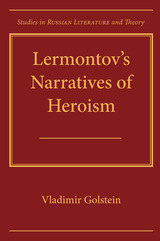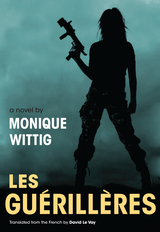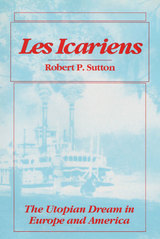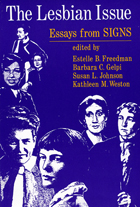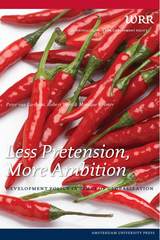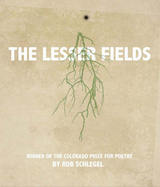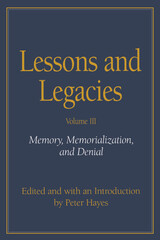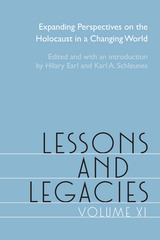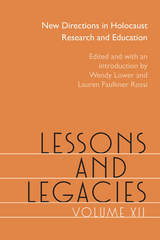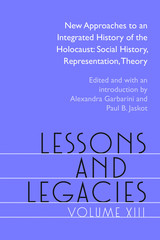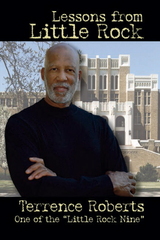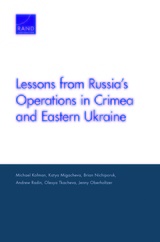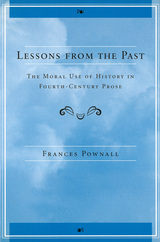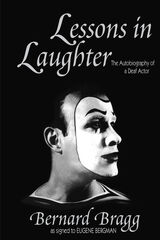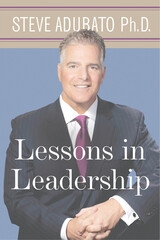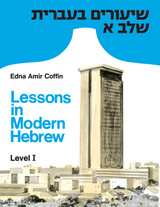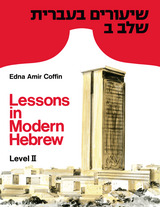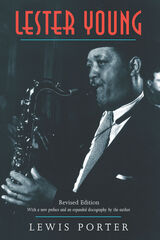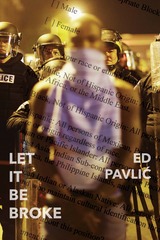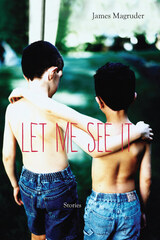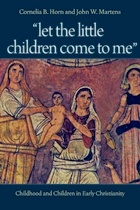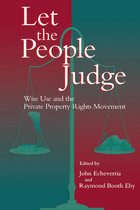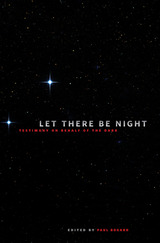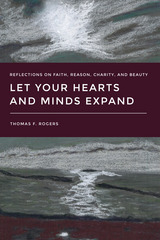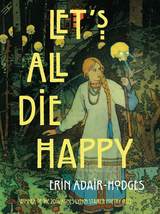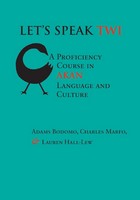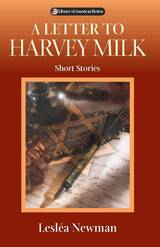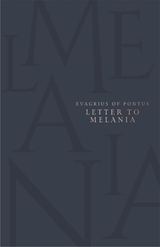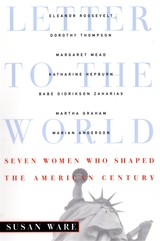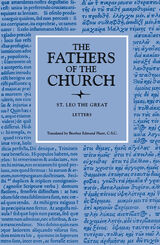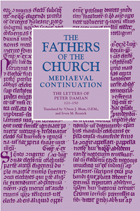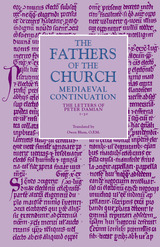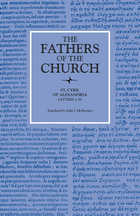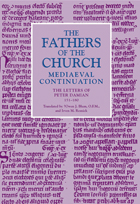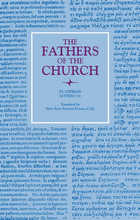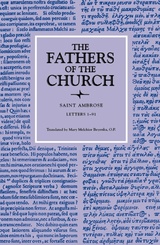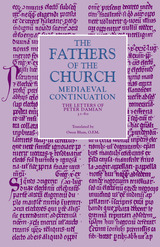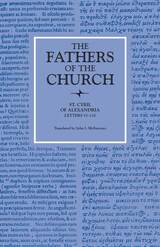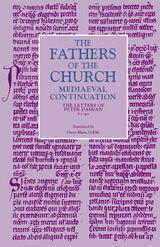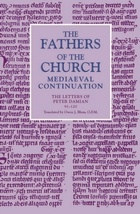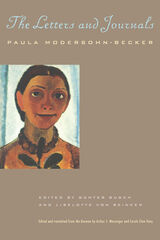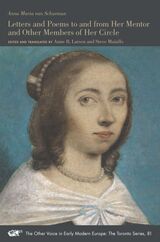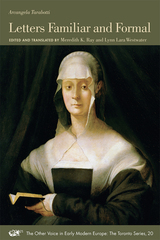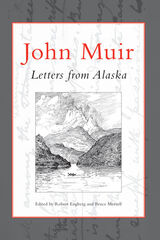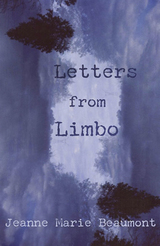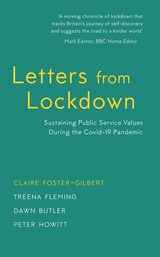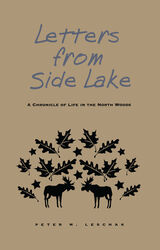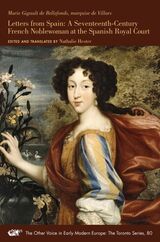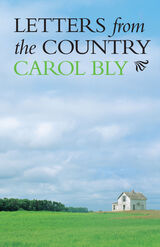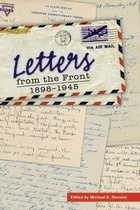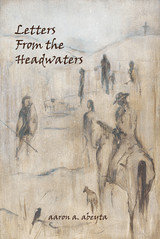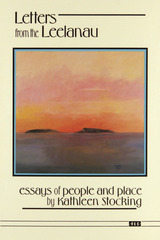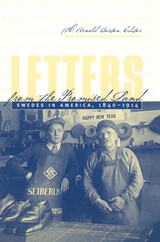Lermontov's Narratives of Heroism
Vladimir Golstein
Northwestern University Press, 2012 This is the first study of Russian writer Mikhail Lermontov (1814-41) that attempts to integrate the in-depth interpretations of all his major texts--including his famous A Hero of Our Time, the novel that laid the foundation for the Russian psychological novel.
Lermontov's explorations of the virtues and limitations of heroic, self-reliant conduct have subsequently become obscured or misread. This new book focuses upon the peculiar, disturbing, and arguably most central feature of Russian culture: its suspicion of and hostility toward individual achievement and self-assertion. The analysis and interpretation of Lermontov's texts enables Golstein to address broader cultural issues by exploring the reasons behind the persistent misreading of Lermontov's major works and by investigating the cultural attitudes that shaped Russia's reaction to the challenges of modernity.
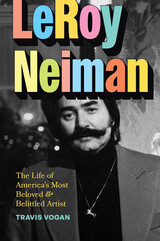 LeRoy Neiman: The Life of America’s Most Beloved and Belittled Artist
Travis Vogan
University of Chicago Press, 2024 The untold story of an American hustler who upset the art world and became a pop culture icon, cutting a swath across twentieth-century history and culture.
LeRoy Neiman—the cigar-smoking and mustachioed artist famous for his Playboy illustrations, sports paintings, and brash interviews—stood among the twentieth century’s most famous, wealthy, and polarizing artists. His stylish renderings of musicians, athletes, and sporting events captivated fans but baffled critics, who accused Neiman of debasing art with popular culture. Neiman cashed in on the controversy, and his extraordinary popularity challenged the norms of what art should be, where it belongs, and who should have access to it.
The story of a Depression-era ragamuffin–turned–army chef–turned–celebrity artist, Neiman’s biography is a rollicking ride through twentieth-century American history, punctuated by encounters with the likes of Muhammad Ali, Frank Sinatra, Joe Namath, and Andy Warhol. In the whirlwind of his life, Neiman himself once remarked that even he didn’t know who he really was—but, he said, the fame and money that came his way made it all worth it. In this first biography of the captivating and infamous man, Travis Vogan hunts for the real Neiman amid the America that made him.
.
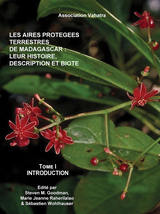 Les aires protégées terrestres de Madagascar: leur histoire, description et biota, tome 1: Introduction
Edited by Steven M. Goodman, Marie Jeanne Raherilalao, and Sébastien Wohlhauser
Association Vahatra, 2020 In 1989, a book written by Martin E. Nicoll and Olivier Langrand was published on the protected areas of Madagascar, which heralded in a new era of conservation for this island nation. In the subsequent three decades, there was an important increase in inventories and studies on Madagascar’s terrestrial biota. This work led to significant changes in the systematics of Malagasy plants and animals, a large percentage unique to the island, and a notable augmentation in knowledge on Malagasy biodiversity. In addition, the considerable expansion of the protected area network, reinforcement of legal tools, and the development of new management modes and tools have contributed to a modernization of the protected area network.
The purpose of the French-language Les aires protégées terrestres de Madagascar is to present a large-scale update of information available from 98 terrestrial protected areas, various analyses to understand general trends in the conservation of these sites, and a synthesis to assess the needs for future scientific programs. Beautifully illustrated throughout with color maps, graphs, and photos, these three volumes will be an important reference for students, researchers, protected area managers, conservationists, and visiting ecotourists. Volume one provides a comprehensive introduction.
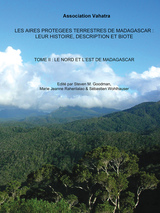 Les aires protégées terrestres de Madagascar: leur histoire, description et biota, tome 2: Le Nord et l'Est de Madagascar
Edited by Steven M. Goodman, Marie Jeanne Raherilalao, and Sébastien Wohlhauser
Association Vahatra, 2020 In 1989, a book written by Martin E. Nicoll and Olivier Langrand was published on the protected areas of Madagascar, which heralded in a new era of conservation for this island nation. In the subsequent three decades, there was an important increase in inventories and studies on Madagascar’s terrestrial biota. This work led to significant changes in the systematics of Malagasy plants and animals, a large percentage unique to the island, and a notable augmentation in knowledge on Malagasy biodiversity. In addition, the considerable expansion of the protected area network, reinforcement of legal tools, and the development of new management modes and tools have contributed to a modernization of the protected area network.
The purpose of the French-language Les aires protégées terrestres de Madagascar is to present a large-scale update of information available from 98 terrestrial protected areas, various analyses to understand general trends in the conservation of these sites, and a synthesis to assess the needs for future scientific programs. Beautifully illustrated throughout with color maps, graphs, and photos, these three volumes will be an important reference for students, researchers, protected area managers, conservationists, and visiting ecotourists. Volume two covers northern and eastern Madagascar.
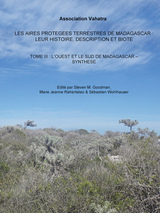 Les aires protégées terrestres de Madagascar: leur histoire, description et biota, tome 3: L'Ouest et le Sud de Madagascar - Synthèse
Edited by Steven M. Goodman, Marie Jeanne Raherilalao, and Sébastien Wohlhauser
Association Vahatra, 2020 In 1989, a book written by Martin E. Nicoll and Olivier Langrand was published on the protected areas of Madagascar, which heralded in a new era of conservation for this island nation. In the subsequent three decades, there was an important increase in inventories and studies on Madagascar’s terrestrial biota. This work led to significant changes in the systematics of Malagasy plants and animals, a large percentage unique to the island, and a notable augmentation in knowledge on Malagasy biodiversity. In addition, the considerable expansion of the protected area network, reinforcement of legal tools, and the development of new management modes and tools have contributed to a modernization of the protected area network.
The purpose of the French-language Les aires protégées terrestres de Madagascar is to present a large-scale update of information available from 98 terrestrial protected areas, various analyses to understand general trends in the conservation of these sites, and a synthesis to assess the needs for future scientific programs. Beautifully illustrated throughout with color maps, graphs, and photos, these three volumes will be an important reference for students, researchers, protected area managers, conservationists, and visiting ecotourists. Volume three covers western and southwestern Madagascar, as well as provides a valuable synthesis.
Les Esprits
Pierre de Larivey
Harvard University Press, 1978 This is the first critical edition of Pierre de Larivey’s Les Esprits, a French Renaissance comedy which not only influenced Molière, but also inspired Camus to write an adaptation for the modern stage. In his introduction, Donald Stone discusses how Les Esprits itself is indebted to Lorenzino de Medici’s L’Aridosio and, in examining how Larivey’s play departs from its Italian source, raises some interesting questions about the morality of French Renaissance comedy and the period’s conception of the genre. Besides ample notes and a glossary, this edition of Les Esprits also includes variants from editions of the play produced during Larivey’s lifetime.
Les Guerilleres
Monique Wittig. Translated from the French by David Le Vay
University of Illinois Press, 2007 One of the most widely read feminist texts of the twentieth century, and Monique Wittig’s most popular novel, Les Guérillères imagines the attack on the language and bodies of men by a tribe of warrior women. Among the women’s most powerful weapons in their assault is laughter, but they also threaten literary and linguistic customs of the patriarchal order with bullets. In this breathtakingly rapid novel first published in 1969, Wittig animates a lesbian society that invites all women to join their fight, their circle, and their community. A path-breaking novel about creating and sustaining freedom, the book derives much of its energy from its vaunting of the female body as a resource for literary invention.
Les Icariens: THE UTOPIAN DREAM IN EUROPE AND AMERICA
Robert P. Sutton
University of Illinois Press, 1994 This is the first complete account of the epic tale of the Icarians and their dream of creating a perfect society without money or property. Robert P. Sutton analyzes the origins of Icarianism in the milieu of French politics in the 1840s, discusses its founder Etienne Cabet, and traces the eventual creation of six communal societies in Illinois, Iowa, and California between 1848 and 1898. Les Icariens is a fascinating amalgam of biography, a history of French Socialism, and the story of one of the longest-lived secular communal experiments in America.
Les Lettres de 1289 et 1305 des ilkhan Aryun et Oljeitu a Phillipe le Bel
Antoine Mostaert and Francis Woodman Cleaves
Harvard University Press This volume, beginning the new Scripta Mongolica Monograph Series, presents two remarkable documents—the letters of 1289 and 1305 from the Mongolian potentates Ilkhan Argun and Ilkhan Olje'itu to Philip the Fair of France. The texts and their implications are thoughtfully discussed with generous annotation. Both documents are fully reproduced in a sequence of excellent plates; the text is transliterated. These valuable materials, along with the volume's enlightening discussion, will be of great value to scholars in the field.
 Les Matériaux: Une autre histoire de l’art moderne
Monika Wagner
Diaphanes, 2025 A French-language edition of Monika Wagner's comprehensive study, originally in German, of the use and significance of materials in twentieth-century art.
Utilizing exemplary works, Monika Wagner considers traditional materials, as well as materials that have been newly developed or are originally foreign to art, placing them beyond the personal mythologies of individual artists and in the context of their ordinary uses and attributes. This critical reconstruction of their meaning opens up a new avenue for understanding modern art. The materials discussed and studied are at the heart of twentieth-century art, from color in painting to everyday and natural objects, and even the most intangible materials such as air and light. The examples chosen by Wagner reveal what these materials tell us in the conjunction of their uses throughout history and their assignments to society or gender. Numerous illustrations complement and illuminate the analyses of the works studied.
 Les Paul: Guitar Wizard
Bob Jacobson
Wisconsin Historical Society Press, 2012 This addition to the Badger Biographies series for young readers tells the story of Les Paul, the legendary “Wizard of Waukesha,” who pioneered the solid body electric guitar, multi-track recording, and many other musical inventions. Fascinated since boyhood with musical technology, the young Les moved from experimenting with his mother’s player piano and phonograph to developing his own amplifier and tinkering with crystal radios. After leaving his hometown of Waukesha at age 17 to pursue a musical career—a decision his mother supported—the budding jazz guitarist lived in Chicago, New York, and Los Angeles, in each city finding a new audience and new musical partnerships. A regular on the radio, Les became a fixture in early television, appearing on the Ed Sullivan Show, and later, a show of his own with partner Mary Ford. Along the way, he overcame numerous physical challenges, including recovery from electric shock and rehabilitation after a horrific car accident—both of which threatened his musical career. And yet, Les Paul pushed musical technology forward more than any other musician of the twentieth century. This Grammy Hall of Fame inductee died in 2009, making Les Paul: Guitar Wizard a timely addition to the series. This lively story is rounded out with sidebars on radio call letters and how an electric guitar works, a full discography, and over 60 historic photographs.
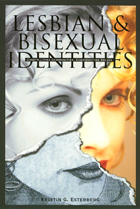 Lesbian & Bisexual Identities
Kristin G. Esterberg
Temple University Press, 1997 This book examines the stories of lesbian and bisexual women in a Northeast community who share who they are, how they have come to see themselves as lesbian or bisexual, and what those identities mean to them. Drawing on social constructionist approaches to identity, Kristin G. Esterberg argues that identities are multiple and contingent. Created within the context of specific communities and within specific relationships, lesbian and bisexual identities are ways of sorting through experiences of desires and attractions, relationships, and politics. Their meanings change over time as women grow older and have more varied experiences, as the communities and sociopolitical worlds in which they live change, and as their life circumstances alter.
In interviews conducted over a four-year time period, women describe the lesbian community they live in; how they see its structure, its social groups, its informal rules and norms for behavior; and their places inside -- or on the margins of -- the community. Lesbian and Bisexual Identities reveals how women fall in and out of love, how they "perform" lesbian or bisexual identity through clothing, hairstyle, body language, and talk, and many other aspects typically not considered. The women present a variety of accounts. Some consider themselves "lesbian from birth" and have constructed their lives accordingly, while others have experienced significant shifts in their identities, depending on the influences of feminism, progressive politics, the visibility of the lesbian community, and other factors.
Esterberg offers vivid accounts that defy the stereotypes so commonly offered. Lesbian and Bisexual Identities not only presents women's stories in their own words, it moves beyond storytelling to understand how these accounts resonate with social science theories of identity and community.
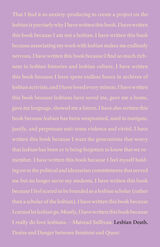 Lesbian Death: Desire and Danger between Feminist and Queer
Mairead Sullivan
University of Minnesota Press, 2022 Engaging with fears of lesbian death to explore the value of lesbian beyond identity
The loss of lesbian spaces, as well as ideas of the lesbian as anachronistic has called into question the place of lesbian identity within our current culture. In Lesbian Death, Mairead Sullivan probes the perception that lesbian status is in retreat, exploring the political promises—and especially the failures—of lesbian feminism and its usefulness today. Lesbian Death reads how lesbian is conceptualized in relation to death from the 1970s onward to argue that lesbian offers disruptive potential. Lesbian Death examines the rise of lesbian breast cancer activism in San Francisco in conversation with ACT UP, the lesbian separatist manifestos “The C.L.I.T. Papers,” the enduring specter of lesbian bed death, and the weaponization of lesbian identity against trans lives. By situating the lesbian as a border figure between feminist and queer, Lesbian Death offers a fresh perspective on the value of lesbian for both feminist and queer projects, even if her value is her death.
 Lesbian Empire: Radical Crosswriting in the Twenties
Gay Wachman
Rutgers University Press, 2001 Gay Wachman provides a critical new reading of sexually radical fiction by British women in the years during and after the First World War. She contrasts works by Sylvia Townsend Warner, Virginia Woolf, Rose Allatini, and Evadne Price with more politically and narratively conservative novels by Radclyffe Hall and Clemence Dane. These writers, she states, formed part of an alternative modernist tradition that functioned both within and against the repressive ideology of the British Empire, using fantasy as a means of reshaping and critiquing a world fragmented by war. Wachman places at the center of this tradition Sylvia Townsend Warner's achievement in undermining the inhibitions that faced women writing about forbidden love. She discusses Warner's use of crosswriting to transpose the otherwise unrepresentable lives of invisible lesbians into narratives about gay men, destabilizing the borders of race, class, and gender and challenging the codes of expression on which imperialist patriarchy and capitalism depended.
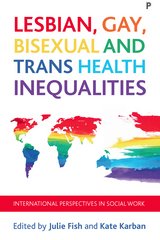 Lesbian, Gay, Bisexual and Trans Health Inequalities: International Perspectives in Social Work
Edited by Julie Fish and Kate Karban
Bristol University Press, 2015 This pioneering study examines inequalities experienced by LGBT people in health care and considers the role of social work in addressing the inequity. The book is organized into three parts: the first provides a policy context in four countries, the second examines social work practice in tackling health inequalities, and the third considers research and pedagogic developments. The volume’s distinctive international approach features practice vignettes as well as key theoretical perspectives on the components of health inequalities, including social determinants of health, minority stress, ecological approaches, and human rights. With a preface from Gary Bailey, president of the International Federation of Social Workers, Lesbian, Gay, Bisexual and Trans Health Inequalities will be relevant to an interdisciplinary, international audience of social work educators, practitioners, and students.
The Lesbian Issue: Essays from Signs
Edited by Estelle B. Freedman, Barbara C. Gelpi, Susan L. Johnson, and Kathleen M. Weston
University of Chicago Press, 1985 This important collection of articles reflects the growing recognition that the study of women whose primary relation is to other women makes a vital contribution to feminist scholarship. A milestone in lesbian studies - a field often trivialized, ignored, or denied, and always controversial - this volume enriches and enlarges our understanding of women in culture and society.
 The Lesbian Menace: Ideology, Identity, and the Representation of Lesbian Life
Sherrie A. Inness
University of Massachusetts Press, 1997 Electroshock. Hysterectomy. Lobotomy. These are only three of the many "cures" to which lesbians have been subjected in this century. How does a society develop such a profound aversion to a particular minority? In what ways do images in the popular media perpetuate cultural stereotypes about lesbians, and to what extent have lesbians been able to subvert and revise those images? This book addresses these and other questions by examining how lesbianism has been represented in American popular culture in the twentieth century and how conflicting ideologies have shaped lesbian experiences and identity.
In the first section, "Inventing the Lesbian," Sherrie A. Inness explores depictions of lesbians in popular texts aimed primarily at heterosexual consumers. She moves from novels of the 1920s to books about life at women's colleges and boarding schools, to such contemporary women's magazines as Cosmopolitan, Glamour, and Vogue.
In the next section, "Forms of Resistance," Inness probes the ways in which lesbians have refashioned texts intended for a heterosexual audience or created their own narratives. One chapter shows how lesbian readers have reinterpreted the Nancy Drew mysteries, looking at them from a distinctly "queer" perspective. Another chapter addresses the changing portrayal of lesbians in children's books over the past two decades.
The last section, "Writing in the Margins," scrutinizes the extent to which lesbians, themselves a marginalized group, have created a society that relegates some of its own members to the outskirts. Topics include the geographic politics of lesbianism, the complex issue of "passing," and the meaning of butch identity in twentieth-century lesbian culture.
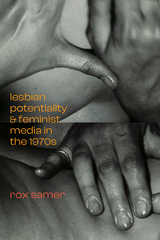 Lesbian Potentiality and Feminist Media in the 1970s
Jed Samer
Duke University Press, 2022 In Lesbian Potentiality and Feminist Media in the 1970s, Jed Samer explores how 1970s feminists took up the figure of the lesbian in broad attempts to reimagine gender and sexuality. Samer turns to feminist film, video, and science fiction literature, offering a historiographical concept called “lesbian potentiality”—a way of thinking beyond what the lesbian was, in favor of how the lesbian signified what could have come to be. Samer shows how the labor of feminist media workers and fans put lesbian potentiality into movement. They see lesbian potentiality in feminist prison documentaries that theorize the prison industrial complex’s racialized and gendered violence and give image to Black feminist love politics and freedom dreaming. Lesbian potentiality also circulates through the alternative spaces created by feminist science fiction and fantasy fanzines like The Witch and the Chameleon and Janus. It was here that author James Tiptree, Jr./Alice B. Sheldon felt free to do gender differently and inspired many others to do so in turn. Throughout, Samer embraces the perpetual reimagination of “lesbian” and the lesbian’s former futures for the sake of continued, radical world-building.
Lesbian Psychologies: EXPLORATIONS AND CHALLENGES
Edited by the Boston Lesbian Psychologies Collective
University of Illinois Press, 1987 This bestselling pioneering anthology brings together a diverse group of twenty-six feminist writers, therapists and academics. Their work represents a beginning effort to capture the experience of contemporary American lesbians. Writing about their own lives as well as the lives of the women they have observed and counseled, the authors explore four topics central to building a lesbian psychology: identity, relationships, community, and therapy.
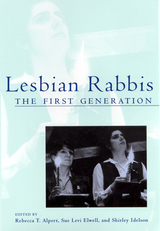 Lesbian Rabbis: The First Generation
Rebecca T. Alpert, Sue Levi Elwell, and Shirley Idelson
Rutgers University Press, 2001 The office of rabbi is the most visible symbol of power and prestige in Jewish communities. Rabbis both interpret to their congregations the requirements of Jewish life and instruct congregants in how best to live this life.
Lesbian Rabbis: The First Generation documents a monumental change in Jewish life as eighteen lesbian rabbis reflect on their experiences as trailblazers in Judaism's journey into an increasingly multicultural world. In frank and revealing essays, the contributors discuss their decisions to become rabbis and describe their experiences both at the seminaries and in their rabbinical positions. They also reflect on the dilemma whether to conceal or reveal their sexual identities to their congregants and superiors, or to serve specifically gay and lesbian congregations. The contributors consider the tensions between lesbian identity and Jewish identity, and inquire whether there are particularly "lesbian" readings of traditional texts. These essays also ask how the language of Jewish tradition touches the lives of lesbians and how lesbianism challenges traditional notions of the Jewish family.
"'Today I am completely 'out' personally and professionally, and yet I have learned that the 'coming out' process never ends. Even today, I find myself in professional situations in which yet again I must reveal that I am a lesbian, yet again I must prove myself worthy of functioning professionally in the 'straight' world. I still encounter moments of awkwardness, some hostility, and some sense of exclusion as I negotiate the pathways of my professional life."-Rabbi Leila Gal Berner, from Lesbian Rabbis: The First Generation
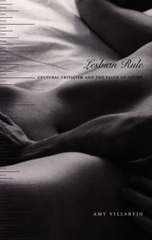 Lesbian Rule: Cultural Criticism and the Value of Desire
Amy Villarejo
Duke University Press, 2003 With hair slicked back and shirt collar framing her young patrician face, Katherine Hepburn's image in the 1935 film Sylvia Scarlett was seen by many as a lesbian representation. Yet, Amy Villarejo argues, there is no final ground upon which to explain why that image of Hepburn signifies lesbian or why such a cross-dressing Hollywood fantasy edges into collective consciousness as a lesbian narrative. Investigating what allows viewers to perceive an image or narrative as "lesbian," Villarejo presents a theoretical exploration of lesbian visibility. Focusing on images of lesbians in film, she analyzes what these representations contain and their limits. She combines Marxist theories of value with poststructuralist insights to argue that lesbian visibility operates simultaneously as an achievement and a ruse, a possibility for building a new visual politics and away of rendering static and contained what lesbian might mean.
Integrating cinema studies, queer and feminist theory, and cultural studies, Villarejo illuminates the contexts within which the lesbian is rendered visible. Toward that end, she analyzes key portrayals of lesbians in public culture, particularly in documentary film. She considers a range of films—from documentaries about Cuba and lesbian pulp fiction to Exile Shanghai and The Brandon Teena Story—and, in doing so, brings to light a nuanced economy of value and desire.
 Lesbians in Early Modern Spain
Sherry Velasco
Vanderbilt University Press, 2011 In this first in-depth study of female homosexuality in the Spanish Empire for the period from 1500 to 1800, Velasco presents a multitude of riveting examples that reveal widespread contemporary interest in women's intimate relations with other women. Her sources include literary and historical texts featuring female homoeroticism, tracts on convent life, medical treatises, civil and Inquisitional cases, and dramas. She has also uncovered a number of revealing illustrations from the period.
The women in these accounts, stories, and cases range from internationally famous transgendered celebrities to lesbian criminals, from those suspected of "special friendships" in the convent to ordinary villagers.
Velasco argues that the diverse and recurrent representations of lesbian desire provide compelling evidence of how different groups perceived intimacy between women as more than just specific sex acts. At times these narratives describe complex personal relationships and occasionally characterize these women as being of a certain "type," suggesting an early modern precursor to what would later be recognized as divergent lesbian, bisexual, and transgender identities.
 Lesbians on Television: New Queer Visibility & the Lesbian Normal
Kate McNicholas Smith
Intellect Books, 2020 A look at the emergence of queer women characters in popular storytelling and the wide-ranging effects of this mainstream representation.
The twenty-first century has seen LGBTQ+ rights emerge at the forefront of public discourse and national politics in ways that would once have been hard to imagine. In Lesbians on Television, Kate McNicholas Smith maps concurrent contemporary shifts in lesbian visibility within popular media, focusing on the small screens of Europe and North America. Central to these shifts has been a re-imagining of queer lives—or a “new queer visibility”—as LGBTQ+ characters have become increasingly visible within popular culture. Kate McNicholas Smith explores this increased visibility through the lens of television, and in doing so, she identifies a “new lesbian normal”—a normalization of lesbian subjects that both helps and hinders those it represents.
Structured around five central case studies of popular British and American television shows featuring lesbian, bisexual, and queer women characters—The L Word, Skins, Glee, Coronation Street, and The Fosters—the book develops a detailed analysis of the shaping of a new “lesbian normal” through representations of LGBTQ+ figures and examines their televisual representation and reception. Presenting critical queer and feminist theory alongside empirical research that includes interviews and multi-platform media analyses, McNicholas Smith works to untangle the social, political, and cultural implications of new visibility in a period of significant social change in the LGBTQ+ experience.
Less Pretension, More Ambition: Development Policy in Times of Globalization
Peter van Lieshout, Robert Went, and Monique Kremer
Amsterdam University Press, 2011
On some levels, the accepted role of development aid has been supplanted by the increase of individual remittances and foreign direct investment, as well as by policies that focus on issues such as climate, migration, financial stability, knowledge, trade, and security in order to increase opportunities in struggling countries. This study considers such changes and examines the effectiveness of aid and its role in international power relations. The editors and contributors close the book by proposing new strategies for development aid in the era of globalization.
 Less Than Charming: A Novel
Rebecca A. Demarest
Parkhurst Brothers, Inc., 2016 A second novel, LESS THAN CHARMING tells the story of a world beyond a veil in which all of the characters writers have ever created are alive and living in their own society. As writers in the other—human world—constantly write new characters into existence, those characters emerge into this mirror world. A hierarchy evolves as every retelling of existing characters is layered onto the original, adding to and changing their personality, knowledge base, and sometimes their emotional stability. Prince Charming conspires to rule the society of characters, which includes every protagonist and foil you’ve ever found in a story or a book, and the prince is not as charming as you first imagine.
One character sands in the Prince’s way—Princess Sophia from Grimm’s lesser known “12 Dancing Princesses.” She’s stable—mostly—but Prince Charming is most definitely not. The good Storyteller and the First Character have tasked Sophia with stopping the Prince from destroying their world, and, by extension, ours.
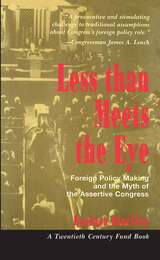 Less than Meets the Eye: Foreign Policy Making and the Myth of the Assertive Congress
Barbara Hinckley
University of Chicago Press, 1994 Focusing on cases involving major military action, foreign aid authorization, and key controversial votes in both legislative branches, Hinckley shows that—appearances to the contrary—Congress more often than not votes with the President, and has done so for the last few decades. Despite occasional flurries of activity on carefully chosen symbolic issues, most foreign policy issues never even make the Congressional agenda. Those that do are often dispatched with demands for reports that are left unread or with tough restrictions having built-in "escape provisions." Both branches, Hinckley argues, encourage this image of conflict and profit from the symbolic political capital it produces. This process comes to light in her analysis of aid to Nicaragua.
What Hinckley reveals is sharply at odds with conventional wisdom and unflattering to both the executive and the legislative branches of government. More than a critical reassessment, this book also proposes reforms than might result in real congressional participation in the making of foreign policy. With its insight into how our system of checks and balances works—and doesn't—this book takes a first step toward making the peoples' representatives accountable for crucial American interests in foreign matters.
The Less Traveled Road: A Study of Robert Frost
Caroline Ford
Harvard University Press In this study of the poetry of Robert Frost, Caroline Ford comes to the conclusion that his poetry is based on convictions of life's meaning, which show amazing consistency with all that he has written. His presentation of this philosophy is unique. Just as he finds provinciality of subject-matter necessary to universal appreciation, he feels that the limited gateway of poetry helps one to understand the major beliefs of life. Belief, to Frost, is the keynote of a man's development and is capable of appearing in many forms. What constitutes pathos in his poetry is essentially the inability of certain people to believe in anything that can furnish them with motives for sustained effort. His optimistic poems, on the other hand, deal with the renewal or success of these major beliefs.
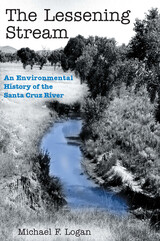 The Lessening Stream: An Environmental History of the Santa Cruz River
Michael F. Logan
University of Arizona Press, 2002 Newcomers to Tucson know the Santa Cruz River as a dry bed that can become a rampaging flood after heavy rains. Yet until the late nineteenth century, the Santa Cruz was an active watercourse that served the region’s agricultural needs—until a burgeoning industrial society began to tap the river’s underground flow. The Lessening Stream reviews the changing human use of the Santa Cruz River and its aquifer from the earliest human presence in the valley to today. Michael Logan examines the social, cultural, and political history of the Santa Cruz Valley while interpreting the implications of various cultures' impacts on the river and speculating about the future of water in the region. Logan traces river history through three eras—archaic, modern, and postmodern—to capture the human history of the river from early Native American farmers through Spanish missionaries to Anglo settlers. He shows how humans first diverted its surface flow, then learned to pump its aquifer, and today fail to fully understand the river's place in the urban environment. By telling the story of the meandering river—from its origin in southern Arizona through Mexico and the Tucson Basin to its terminus in farmland near Phoenix—Logan links developments throughout the river valley so that a more complete picture of the river's history emerges. He also contemplates the future of the Santa Cruz by confronting the serious problems posed by groundwater pumping in Tucson and addressing the effects of the Central Arizona Project on the river valley. Skillfully interweaving history with hydrology, geology, archaeology, and anthropology, The Lessening Stream makes an important contribution to the environmental history of southern Arizona. It reminds us that, because water will always be the focus for human activity in the desert, we desperately need a more complete understanding of its place in our lives.
 The Lesser Declamations, Volume I
Quintilian
Harvard University Press, 2006 Mock trial—Roman style.
The Lesser Declamations, dating perhaps from the second century AD and attributed to Quintilian, might more accurately be described as emanating from “the school of Quintilian.” The collection—here made available for the first time in translation—represents classroom materials for budding Roman lawyers.
The instructor who composed these specimen speeches for fictitious court cases adds his comments and suggestions concerning presentation and arguing tactics—thereby giving us insight into Roman law and education. A wide range of scenarios is imagined. Some evoke the plots of ancient novels and comedies: pirates, exiles, parents and children in conflict, adulterers, rapists, and wicked stepmothers abound. Other cases deal with such matters as warfare between neighboring cities, smuggling, historical (and quasi-historical) events, tyrants and tyrannicides. Two gems are the speech opposing a proposal to equalize wealth, and the case of a Cynic youth who has forsworn worldly goods but sues his father for cutting off his allowance.
Of the original 388 sample cases in the collection, 145 survive. These are now added to the Loeb Classical Library in a two-volume edition, a fluent translation by D. R. Shackleton Bailey facing an updated Latin text.
 The Lesser Declamations, Volume II
Quintilian
Harvard University Press, 2006 Mock trial—Roman style.
The Lesser Declamations, dating perhaps from the second century AD and attributed to Quintilian, might more accurately be described as emanating from “the school of Quintilian.” The collection—here made available for the first time in translation—represents classroom materials for budding Roman lawyers.
The instructor who composed these specimen speeches for fictitious court cases adds his comments and suggestions concerning presentation and arguing tactics—thereby giving us insight into Roman law and education. A wide range of scenarios is imagined. Some evoke the plots of ancient novels and comedies: pirates, exiles, parents and children in conflict, adulterers, rapists, and wicked stepmothers abound. Other cases deal with such matters as warfare between neighboring cities, smuggling, historical (and quasi-historical) events, tyrants and tyrannicides. Two gems are the speech opposing a proposal to equalize wealth, and the case of a Cynic youth who has forsworn worldly goods but sues his father for cutting off his allowance.
Of the original 388 sample cases in the collection, 145 survive. These are now added to the Loeb Classical Library in a two-volume edition, a fluent translation by D. R. Shackleton Bailey facing an updated Latin text.
The Lesser Fields
Rob Schlegel
University Press of Colorado, 2009 Winner of the 2009 Colorado Prize for Poetry
Published by the Center for Literary Publishing at Colorado State University
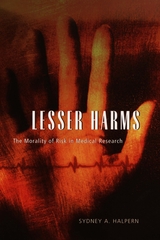 Lesser Harms: The Morality of Risk in Medical Research
Sydney A. Halpern
University of Chicago Press, 2004 Research physicians face intractable dilemmas when they consider introducing new medical procedures. Innovations carry the promise of preventing or curing life-threatening diseases, but they can also lead to injury or even death. How have clinical scientists made high-stakes decisions about undertaking human tests of new medical treatments? In Lesser Harms, Sydney Halpern explores this issue as she examines vaccine trials in America during the early and mid-twentieth century. Today's scientists follow federal guidelines for research on human subjects developed during the 1960s and 1970s. But long before these government regulations, medical investigators observed informal rules when conducting human research. They insisted that the dangers of natural disease should outweigh the risks of a medical intervention, and they struggled to accurately assess the relative hazards. Halpern explores this logic of risk in immunization controversies extending as far back as the eighteenth century. Then, focusing on the period between 1930 and 1960, she shows how research physicians and their sponsors debated the moral quandaries involved in moving vaccine use from the laboratory to the clinic. This probing work vividly describes the efforts of clinical investigators to balance the benefits and dangers of untested vaccines, to respond to popular sentiment about medical hazards, and to strategically present risk laden research to sponsors and the public. “Concise and extremely well-written. . . . A fascinating synthesis of sociology, history, and institutional theory.”—Samuel C. Blackman, Journal of the American Medical Association
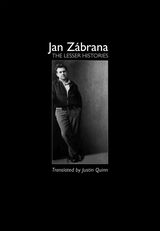 The Lesser Histories
Jan Zábrana
Karolinum Press, 2022 The first collection of poetry in English by an acclaimed twentieth-century Czech writer.
From the eighth floor of a tower block in Central Europe, Jan Zábrana surveyed the twentieth century. He had been exiled from his own life by Communism. His parents were imprisoned, their health was broken, and he was not allowed to study languages in college. Refusing both to rebel outright or to cave in, he thought of himself as a dead man walking. “To all those who keep asking me to do things for them, I sometimes feel like saying: ‘But I’m dead. I died long ago. Why do you keep treating me as if I were one of the living?’”
Yet during some of Europe’s most difficult years, he wrote The Lesser Histories, a collection of sixty-four sonnets that range through themes of age, sex, and political repression—a radiant testament to his times. The lines are emptied both of personal pathos and political stridency. Often Zábrana’s own voice segues into those of poets he had translated over the years, leaving only a bare shimmer of subjectivity—humorous, oblique, pained—with which to view his own works and days. The poems document a splendid and bitter isolation, and are immersed in the humor, hatreds, and loves of the everyday. Published in Czech in the ill-fated year of 1968, they subsequently fell into neglect. After the fall of Communism in 1989, Zábrana’s collected poems and selected diaries were published in Czech, and he was acclaimed as a major twentieth-century writer. Now, with this collection, he can begin to reach English-language readers for the first time.
 A Lesser Light: A Novel
Peter Geye
University of Minnesota Press, 2025 On the rocky shores of Lake Superior, a piercing story of selfhood and determinism develops: is the future what we’re handed or what we make of it?
It’s 1910, and Theodulf Sauer has finally achieved a position befitting his ego: master lighthouse keeper at a newly commissioned station towering above Lake Superior. When his new wife, Willa, arrives on the first spring ferry, it’s clear her life has taken the opposite turn: after being summoned home from college to Duluth when her father dies, she and her scheming mother find themselves destitute, and Willa is rushed into this ill-suited arranged marriage before she can comprehend her fate.
As the lighthouse station establishes, the new relationship teeters between tense and hostile, with little mutual understanding or tenderness. Willa takes solace in her learned fascination with the cosmos, especially (despite her husband’s suspicion of the event) in viewing the imminent Halley’s Comet. Under ominous night skies, Theodulf stands sentry over the lake, clinging to long-ago and faraway memories of happiness that fill him with longing and shame. Into this impasse, a clairvoyant girl and her resolute uncle emerge from across the cove. They see through the Sauers’ thin façade and, by turns and in different ways, convey promise, sympathy, and insight that counter Willa’s despair. Armed with renewed self-determination, Willa forges a path to happiness. But before she can grasp it, tragedy comes to their remote beacon, and her future plunges toward a dark unknown. Set against a brooding and beautiful landscape, A Lesser Light is a story about industry and calamity, science versus superstition, inner desire countered with societal expectations—and the consequences when these forces collide in the wilderness of rapid social change.
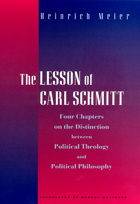 The Lesson of Carl Schmitt: Four Chapters on the Distinction between Political Theology and Political Philosophy
Heinrich Meier
University of Chicago Press, 1998 This book is the culmination of Heinrich Meier's acclaimed analyses of the controversial thought of Carl Schmitt. Meier identifies the core of Schmitt's thought as political theology—that is, political theorizing that claims to have its ultimate ground in the revelation of a mysterious or supra-rational God. This radical, but half-hidden, theological foundation unifies the whole of Schmitt's often difficult and complex oeuvre, cutting through the intentional deceptions and unintentional obfuscations that have eluded previous commentators.
Relating this religious dimension to Schmitt's support for National Socialism and his continuing anti-Semitism, Meier compels the reader to come to terms with the irreconcilable differences between political theology and political philosophy. His book will give pause to those who have tended to gloss over the troubling aspects of some of Schmitt's ideas.
With editions in German, French, Italian, and now English, Meier's two books on Schmitt have dramatically reoriented the international debate about Carl Schmitt and his significance for twentieth-century political thought.
"Standing far above the rest . . . is Heinrich Meier's new study, Die Lehre Carl Schmitts, which covers all of Schmitt's writings. . . . Meier's work has forced everyone to take a second look at the assumptions underlying Schmitt's better-known writings and reconsider some that have been ignored."—Mark Lilla, reviewing the German edition in The New York Review of Books
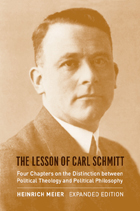 The Lesson of Carl Schmitt: Four Chapters on the Distinction between Political Theology and Political Philosophy, Expanded Edition
Heinrich Meier
University of Chicago Press, 2011 Heinrich Meier’s work on Carl Schmitt has dramatically reoriented the international debate about Schmitt and his significance for twentieth-century political thought. In The Lesson of Carl Schmitt, Meier identifies the core of Schmitt’s thought as political theology—that is, political theorizing that claims to have its ultimate ground in the revelation of a mysterious or suprarational God. This radical, but half-hidden, theological foundation underlies the whole of Schmitt’s often difficult and complex oeuvre, rich in historical turns and political convolutions, intentional deceptions and unintentional obfuscations. In four chapters on morality, politics, revelation, and history, Meier clarifies the difference between political philosophy and Schmitt’s political theology and relates the religious dimension of his thought to his support for National Socialism and his continuing anti-Semitism. New to this edition are two essays that address the recently published correspondences of Schmitt—particularly with Hans Blumberg—and the light it sheds on his conception of political theology.
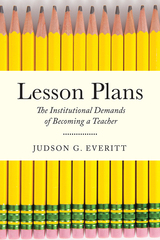 Lesson Plans: The Institutional Demands of Becoming a Teacher
Everitt, Judson G.
Rutgers University Press, 2017 Winner of the 2019-20 Distinguished Book Award - Midwest Sociological Society
In Lesson Plans, Judson G. Everitt takes readers into the everyday worlds of teacher training, and reveals the complexities and dilemmas teacher candidates confront as they learn how to perform a job that many people assume anybody can do. Using rich qualitative data, Everitt analyzes how people make sense of their prospective jobs as teachers, and how their introduction to this profession is shaped by the institutionalized rules and practices of higher education, K-12 education, and gender. Trained to constantly adapt to various contingencies that routinely arise in schools and classrooms, teacher candidates learn that they must continually try to reconcile the competing expectations of their jobs to meet students’ needs in an era of accountability. Lesson Plans reveals how institutions shape the ways we produce teachers, and how new teachers make sense of the multiple and complicated demands they face in their efforts to educate students.
Lessons and Legacies I: The Meaning of the Holocaust in a Changing World
Peter Hayes
Northwestern University Press, 1991 Nearly half a century after the Nazi massacre of the Jews in Europe, the Holocaust is now moving from the domain of experience to that of history. It is becoming the subject of recorded rather than living memory. Is real comprehension of the development and horror of the Nazi onslaught accessible to us? If so, through what intellectual processes or categories of understanding, and in the face of what temptations or diversions? How can we preserve, expand, and apply our knowledge of why and how barbarity came to prevail? What meaning can present and future generations derive from the catastrophe? These are the vital questions addressed by the essays in this volume.
 Lessons and Legacies II: Teaching the Holocaust in a Changing World
Donald G. Schilling
Northwestern University Press, 1998 In the years following the demise of the Third Reich, the task of Holocaust education fell predominantly to survivors. Now, as the generation of survivors passes along this responsibility, growing numbers of individuals and institutions are committed to Holocaust education.
Lessons and Legacies II focuses on matters unique to Holocaust education. Consisting of selected papers delivered at the second Lessons and Legacies conference in 1992, the volume is organized in three sections: Issues, Resources, and Applications. Taken individually, the essays speak directly to specific concerns surrounding Holocaust education: the growing maturity of the Holocaust as a field of study; the difficult issue of explaining the perpetrators' behavior; the process of decision-making within Jewish communities during the Holocaust; issues of gender and family; the scope and content of survivor literature; and the structure of courses and the implications of being an educator in the field. Taken as a whole, the volume speaks to the reciprocal and mutually reinforcing relationship between teaching and scholarship in this important field.
Lessons and Legacies III: Memory, Memorialization, and Denial
Peter Hayes
Northwestern University Press, 1999 The process of looking back on the Holocaust is one of a double nature: it can bring both enlightenment and a paralyzing pain, particularly for its survivors. This volume addresses the process of looking back, the challenges to understanding of unimaginable horrors that took place, and how academia, media, popular attitudes, and even judicial mind-sets handle that process.
A collection of nineteen essays, this book is organized into four sections: the first focuses on how various fields of study can open new perspectives on the Holocaust and sharpen old ones; the second examines culture and politics in Germany before and after 1933; the third addresses the problems associated with the memorialization of those years; and the final section examines the shocking denials of the Holocaust.
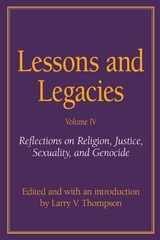 Lessons and Legacies IV: Reflections on Religion, Justice, Sexuality, and Genocide
Larry V. Thompson
Northwestern University Press, 2003 In authoritative, nonpolemical essays on some of the latest and most contentious issues surrounding the Holocaust, the contributors to this volume revisit some topics central to Holocaust studies, such as the stance of the papacy and the concern about the uses to which the meaning of the Holocaust has been put, while expanding research into less-examined areas such as propriety, sexuality, and proximity.
Variously concerned with issues of guilt and victimization, the essays examine individuals like Pius XII and Romano Guardini and the institutions of organized religion as well as the roles of the Jewish Councils and the retributive judicial proceedings in Hungary. They reveal that victimization within the Holocaust experience is surprisingly open-ended, with Jewish women doubly victimized by their gender; postwar Germans viewing themselves as the epoch's greatest victims; Poles, whether Jewish or not, victimized beyond others because of their proximity to the epicenter of the Holocaust; and German university students corrupted by ideological inculcation and racist propaganda.
Though offering no "positive lessons" or comforting assurances, these essays add to the ongoing examination of Holocaust consequences and offer insightful analyses of facets previously minimized or neglected. Together they illustrate that matters of gender, sexuality, and proximity are crucial for shaping perceptions of a Holocaust reality that will always remain elusive.
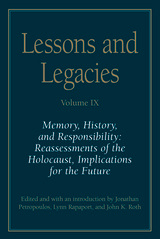 Lessons and Legacies IX: Memory, History, and Responsibility: Reassessments of the Holocaust, Implications for the Future
Jonathan Petropoulos
Northwestern University Press, 2010 Memory, History, and Responsibility: Reassessments of the Holocaust, Implications for the Future contains the highlights from the ninth "Lessons and Legacies" conference. The conference, held during the height of the genocide in Darfur, sought to reexamine how the darkness of the Holocaust continues to shadow human existence more than sixty years after World War II left the Third Reich in ruins. The collection opens with Saul Friedländer’s call for interdisciplinary approaches to Holocaust research. The essays that follow draw on the latest methodologies in the fields of history, literature, philosophy, religion, film, and gender studies, among others. Together both the leading scholars of the Holocaust and the next generation of scholars engage the difficult reality—as raised by editors Petropoulos, Rapaport, and Roth in their introduction—that the legacies of the Holocaust have not proved sufficient in intervening against human-made mass death, let alone preventing or eliminating it.
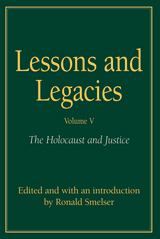 Lessons and Legacies V: The Holocaust and Justice
Ronald Smelser
Northwestern University Press, 2002 How can one link the Holocaust and justice, given the enormity of the Holocaust? Is justice even possible for a crime of such magnitude, and if so, what kind of justice? Weighing these questions and their implications, a group of distinguished scholars attempts to untangle the complex and often contradictory conjunction of the Holocaust and justice.
Seeking a historical context, the contributors ask, What were the political, social, psychological, and ideological prerequisites for this tragedy? Considering the courts and trials both during and immediately after World War II, and recent cases against aging perpetrators, the contributors examine the legal circumstances for trying to provide justice, the dimming impact of passing time, and other issues that complicate litigation. Their inquiry extends to questions about memory--how it is shaped and reshaped and whether it can be reliable--and about the re-creation of events of the Holocaust by a second generation. Does reassembling the evidence through the lenses of a later generation provide a deeper understanding, and does this understanding include a sense of justice accomplished?
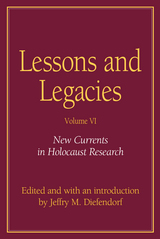 Lessons and Legacies VI: New Currents in Holocaust Research
Jeffry Diefendorf
Northwestern University Press, 2004 In the courtroom and the classroom, in popular media, public policy, and scholarly pursuits, the Holocaust-its origins, its nature, and its implications-remains very much a matter of interest, debate, and controversy. Arriving at a time when a new generation must come to terms with the legacy of the Holocaust or forever lose the benefit of its historical, social, and moral lessons, this volume offers a richly varied, deeply informed perspective on the practice, interpretation, and direction of Holocaust research now and in the future. In their essays the authors-an international group including eminent senior scholars as well those who represent the future of the field-set the agenda for Holocaust studies in the coming years, even as they give readers the means for understanding today's news and views of the Holocaust, whether in court cases involving victims and perpetrators; international, national, and corporate developments; or fictional, documentary, and historical accounts.
Several of the essays-such as one on nonarmed "amidah" or resistance and others on the role of gender in the behavior of perpetrators and victims-provide innovative and potentially significant interpretive frameworks for the field of Holocaust studies. Others; for instance, the rounding up of Jews in Italy, Nazi food policy in Eastern Europe, and Nazi anti-Jewish scholarship, emphasize the importance of new sources for reconstructing the historical record. Still others, including essays on the 1964 Frankfurt trial of Auschwitz guards and on the response of the Catholic Church to the question of German guilt, bring a new depth and sophistication to highly charged, sharply politicized topics. Together these essays will inform the future of the Holocaust in scholarly research and in popular understanding.
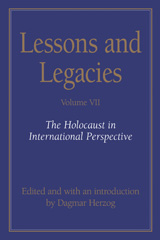 Lessons and Legacies VII: The Holocaust in International Perspective
Dagmar Herzog
Northwestern University Press, 2006 As the discipline of Holocaust studies matures, new questions and themes come to the fore. Among these are critical issues that receive serious scholarly attention, often for the first time, in this collection of essays by some of the world's most respected experts in the field. Greed and theft as motives for Holocaust perpetrators and bystanders; sexual violence and what it tells us about the experiences of both victims and perpetrators; collaboration with Nazis among the local populations of the ever-moving Eastern front; the durability of anti-Semitism after 1945; and the perspectives of the Soviet military and Soviet leadership on Nazi crimes: these are some of the topics the authors address as they extend the boundaries of Holocaust scholarship beyond the central loci of the planning and execution of technologized mass murder--Germany and Poland--and into ghettos and killing fields in Ukraine and Belarus, as well as spaces whose boundaries and national identities changed repeatedly. The authors also look to Western Europe and consider the expropriation of Dutch Jews and the exigencies of post-Holocaust filmmaking in France; they draw insights from recent genocides such as those in Cambodia and Rwanda, and provide new critical analyses of the course and meaning of contested responses to the Shoah in nations and locations long and deeply studied.
A thorough, thoughtful, and insightful introduction clarifies the volume's themes and concisely places them within the larger context of Holocaust scholarship; and an introductory essay by Omer Bartov brings into focus the numerous paradoxes structuring early twenty-first-century retrospective thinking about the significance of the Holocaust as a central theme of the twentieth century.
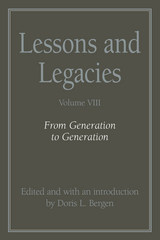 Lessons and Legacies VIII: From Generation to Generation
Doris L. Bergen
Northwestern University Press, 2008 Primo Levi opened his memoir Survival in Auschwitz with a call to remember, reflect upon, and teach about the Holocaust—or to face the rejection of subsequent generations. The transmittal of this urgent knowledge between generations was the theme of the eighth Lessons and Legacies Conference on the Holocaust, and it is the focus of this volume. The circular formulation—from generation to generation—points backward and forward: where do we locate the roots of the Holocaust, and how do its repercussions manifest themselves? The contributors address these questions from various perspectives—history, cultural studies, psychiatry, literature, and sociology. They also bring to bear the personal aspect of associated issues such as continuity and rupture. What has the generation of the Shoah passed on to its descendants? What have subsequent generations taken from these legacies? Contributions by scholars, some of whom are survivors and children of survivors, remind us that the Holocaust does—and must—remain present from generation to generation.
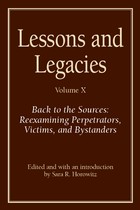 Lessons and Legacies X: Back to the Sources: Reexamining Perpetrators, Victims, and Bystanders
Sara R Horowitz
Northwestern University Press, 2012 The essays in the tenth volume of Lessons and Legacies offer a sense of the issues that run through current thinking about the Holocaust and ideas about the different ways we engage with a broad range of sources. New sources ranging from traditional archival finds to microhistories accessible via newer technology infuse Holocaust research. At the same time, the fields of Holocaust research and Jewish studies have an increasing impact upon other disciplines. Overall, the editor and writers find that the integration of insights, methodologies, critiques, and questions from psychology, literary studies, visual arts, and other fields with those of history, political science, and other social sciences sharpens the tools of analysis. The essays in this volume testify to the evolution of the field of Holocaust studies and also indicate a future direction.
Lessons and Legacies XI: Expanding Perspectives on the Holocaust in a Changing World
Edited and with an introduction by Hilary Earl and Karl A. Schleunes
Northwestern University Press, 2015 “Expanding Perspectives on the Holocaust in a Changing World” was the theme of the eleventh Lessons and Legacies Conference on the Holocaust. The eighteen essays published here, which sprung from the conference, reflect questions that Holocaust scholars are asking in the face of shifting political, economic, social, and disciplinary contexts. These questions are addressed from various perspectives including Jewish studies, history, cultural studies (film and memory), literary studies, legal studies, and geography. The book opens with the contentious issues raised in the keynote addresses of Omer Bartov and Timothy Snyder, which highlight the fact that the Holocaust, a once untold history, is now a central component of a wide-ranging scholarship not limited to German history.
Lessons and Legacies XII: New Directions in Holocaust Research and Education
Edited and with an introduction by Wendy Lower and Lauren Faulkner Rossi
Northwestern University Press, 2017 Lessons and Legacies XII explores new directions in research and teaching in the field of Holocaust studies. The essays in this volume present the most cutting-edge methods and topics shaping Holocaust studies today, from a variety of disciplines: forensics, environmental history, cultural studies, religious studies, labor history, film studies, history of medicine, sociology, pedagogy, and public history. This rich compendium reveals how far Holocaust studies have reached into cultural studies, perpetrator history, and comparative genocide history. Scholars, laypersons, teachers, and the myriad organizations devoted to Holocaust memorialization and education will find these essays useful and illuminating.
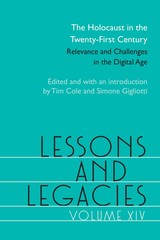 Lessons and Legacies XIV: The Holocaust in the Twenty-First Century; Relevance and Challenges in the Digital Age
Edited and with an introduction by Tim Cole and Simone Gigliotti
Northwestern University Press, 2021 The Holocaust in the Twenty-First Century: Relevance and Challenges in the Digital Age challenges a number of key themes in Holocaust studies with new research. Essays in the section “Tropes Reconsidered” reevaluate foundational concepts such as Primo Levi’s gray zone and idea of the muselmann. The chapters in “Survival Strategies and Obstructions” use digital methodologies to examine mobility and space and their relationship to hiding, resistance, and emigration. Contributors to the final section, “Digital Methods, Digital Memory,” offer critical reflections on the utility of digital methods in scholarly, pedagogic, and public engagement with the Holocaust. Although the chapters differ markedly in their embrace or eschewal of digital methods, they share several themes: a preoccupation with the experiences of persecution, escape, and resistance at different scales (individual, group, and systemic); methodological innovation through the adoption and tracking of micro- and mezzohistories of movement and displacement; varied approaches to the practice of Saul Friedländer’s “integrated history”; the mainstreaming of oral history; and the robust application of micro- and macrolevel approaches to the geographies of the Holocaust. Taken together, these chapters incorporate gender analysis, spatial thinking, and victim agency into Holocaust studies. In so doing, they move beyond existing notions of perpetrators, victims, and bystanders to portray the Holocaust as a complex and multilayered event.
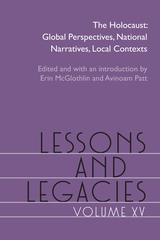 Lessons and Legacies XV: The Holocaust; Global Perspectives, National Narratives, Local Contexts
Erin McGlothlin; Avinoam Patt
Northwestern University Press, 2024 The fifteenth volume in the Lessons & Legacies series, featuring multidisciplinary research in the Holocaust and Jewish cultural history on the theme of Global Perspectives and National Narratives. The fourteen chapters included in this volume manifest three broad categories: history, literature, and memory. These chapters continue the recent trend in Holocaust Studies of a focus on local history, integrating specific regional and national narratives into a more global approach to the event. Newer studies have continued to incorporate what was once termed the periphery into a more global examination of the experiences of Jewish refugees in flight to Latin America, Africa, and the Soviet Union. At the same time, very specific local studies deepen our knowledge of the mechanics of genocide, along with the experiences of refugees in flight, and the subsequent dimensions of Holocaust memory and representation.
New research on Holocaust literature continues to unearth unexamined texts from the period of the war itself, which can shed light on Jewish responses to persecution and strategies for survival. The study of Holocaust testimonies continues to grapple with the challenge of language: how to convey through the limits of human language the depths of barbarity to an audience that could never fully understand what they had not personally experienced. Likewise, literary studies continue to incorporate texts that were once considered outside the standard canon of Holocaust literature, such as science fiction and children’s literature.
The tension between local and global perspectives can also be seen quite clearly in what the volume's editors understand by the term “memory studies,” or new approaches to research on museums and memorials. The very specific nature of collective memory on the national level continues to be the site of the contested “politics of memory.” A number of the chapters in this volume engage with the conflict of monuments and memorials, museums’ attempts to resolve provenance issues, questions around the ethics of Holocaust tourism, and the inclusion of new technologies and digital survivors into the memorial landscape.
 Lessons from a Multispecies Studio: Uncovering Ecological Understanding and Biophilia through Creative Reciprocity
Julie Andreyev
Intellect Books, 2021 A collection of nonfiction, first-person writings about creative collaborations with local animals and ecologies.
In this highly original book, Julie Andreyev explores agency and consciousness through her encounters with other lifeforms—companion dogs, wild birds, mineral beings, plant life, and forest communities—to illuminate the ways creativity can play a part in generating a renewed sense of wonder and kinship with nature. Drawing from her extensive work in interspecies collaborative art, each chapter weaves together personal reflection, interdisciplinary research, and critical thought with new media, sound, generative, indeterminacy, and other art methods. The threads converge on this main point: the need to move away from anthropocentrism and towards ecological understanding through reciprocity and biophilia. The local journeys in each chapter are guided by more-than-human ways of knowing, which provide an expanded sense of the world and underscore the imperative to act. This book invites readers to step into other worlds, re-sense life, and re-think their relationship with the planet and all of its inhabitants. In proposing an expanded field of aesthetics, Andreyev offers new applied approaches from interspecies art to help shape and evolve human outlooks, emotions, and actions.
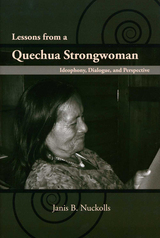 Lessons from a Quechua Strongwoman: Ideophony, Dialogue, and Perspective
Janis B. Nuckolls
University of Arizona Press, 2010 Using the intriguing stories and words of a Quechua-speaking woman named Luisa Cadena from the Pastaza Province of Ecuador, Janis B. Nuckolls reveals a complex language system in which ideophony, dialogue, and perspective are all at the core of cultural and grammatical communications among Amazonian Quechua speakers.
This book is a fascinating look at ideophones—words that communicate succinctly through imitative sound qualities. They are at the core of Quechua speakers’ discourse—both linguistic and cultural—because they allow agency and reaction to substances and entities as well as beings. Nuckolls shows that Luisa Cadena’s utterances give every individual, major or minor, a voice in her narrative. Sometimes as subtle as a barely felt movement or unintelligible sound, the language supports an amazingly wide variety of voices.
Cadena’s narratives and commentaries on everyday events reveal that sound imitation through ideophones, representations of dialogues between humans and nonhumans, and grammatical distinctions between a speaking self and an other are all part of a language system that allows for the possibility of shared affects, intentions, moral values, and meaningful, communicative interactions between humans and nonhumans.
 Lessons from an Optical Illusion: On Nature and Nurture, Knowledge and Values
Edward M. Hundert
Harvard University Press, 1995 Facts are facts, we often say with certainty; but values--well, they're relative. But every day we are confronted with situations where these simple distinctions begin to blur--whether our concerns are the roots of crime and violence, the measure of intelligence, the causes of disease, the threat and promise of genetic engineering. Where do our "facts" end and our "values" begin?
Recent developments in neuroscience have begun to shed light on this confusion, by radically revising our notions of where human nature ends and human nurture begins. As Edward Hundert--a philosopher, psychiatrist, and award-winning educator--makes clear in this eloquent interdisciplinary work, the newly emerging model for the interactions of brain and environment has enormous implications for our understanding of who we are, how we know, and what we value.
Lessons from an Optical Illusion is a bold modern recasting of the age-old nature-nurture debate, informed by revolutionary insights from brain science, artificial intelligence, psychiatry, linguistics, evolutionary biology, child development, ethics, and even cosmology. As this radical new synthesis unfolds, we are introduced to characters ranging from Immanuel Kant to Gerald Edelman, from Charles Darwin to Sigmund Freud, from Jean Piaget to Stephen Hawking, from Socrates to Jonas Salk. Traversing the nature-nurture terrain, we encounter simulated robots, optical illusions, game theory, the anthropic principle, the prisoner's dilemma, and the language instinct. In the course of Hundert's wide-ranging exploration, the comfortable dichotomies that once made sense (objectivity-subjectivity, heredity-environment, fact-value) break down under sharp analysis, as he reveals the startling degree to which facts are our creations and values are woven into the fabric of the world. Armed with an updated understanding of how we became who we are and how we know what we know, readers are challenged to confront anew the eternal question of what it means to live a moral life.
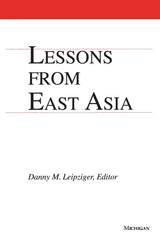 Lessons from East Asia
Danny M. Leipziger, Editor
University of Michigan Press, 2001 This compilation of case studies and cross-country essays focuses on the role of public policy in the experience of East Asian economies. A major theme running through the volume is regional learning and regional contagion--the spread of that learning. Beginning with the model and experience of Japan and continuing with the impressive achievements of countries originally considered unviable in the 1950s and 1960s, like Korea and Taiwan, contributors demonstrate how regional policy lessons permeated borders easily. The 1980s brought further lessons and flows of capital to the second generation of rapid industrializers. And the 1990s have seen regional contagion benefit new aspirants like Vietnam. As the chapters cumulatively reveal, however, the transferability of lessons depends on the institutional framework in which policy is formulated, the consistency of policy, and the quality of implementation.
Part 1 includes the case studies for the first generation of rapidly developing East Asian economics--the tigers--while Part 2 incorporates the later generation success stories--the cubs--plus the Philippines, a country only now beginning to show significant progress. Part 3 includes cross-country essays on public investment, foreign direct investment, and cross-country patterns that synthesize the lessons learned and propose actions for other development aspirants to pursue.
The essays aim to fill two major gaps--the paucity of country-specific work on the institutional side of development policy and the failure to explain the mixed record of industrial policies in East Asia. The volume will appeal to students, scholars, and policymakers in development economics.
Danny M. Leipziger is Lead Economist, Latin America Region, World Bank.
This title was formally part of the Studies in International Trade Policy Series, now called Studies in International Economics.
Lessons from Little Rock
Terrance Roberts
Butler Center for Arkansas Studies, 2009 Sober news reports of a U.S. Army convoy rumbling across the bridge into Little Rock cannot overpower this intimate, powerful, personal account of the integration of Little Rock Central High School. Showing what it felt like to be one of those nine students who wanted only a good high school education, Roberts’s rich narrative and candid voice take readers through that rocky year, helping us realize that the historic events of the Little Rock integration crisis happened to real people—to children, parents, our fellow citizens.
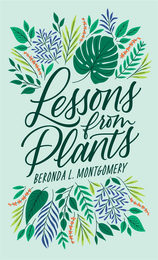 Lessons from Plants
Beronda L. Montgomery
Harvard University Press, 2021 An exploration of how plant behavior and adaptation offer valuable insights for human thriving.
We know that plants are important. They maintain the atmosphere by absorbing carbon dioxide and producing oxygen. They nourish other living organisms and supply psychological benefits to humans as well, improving our moods and beautifying the landscape around us. But plants don’t just passively provide. They also take action.
Beronda L. Montgomery explores the vigorous, creative lives of organisms often treated as static and predictable. In fact, plants are masters of adaptation. They “know” what and who they are, and they use this knowledge to make a way in the world. Plants experience a kind of sensation that does not require eyes or ears. They distinguish kin, friend, and foe, and they are able to respond to ecological competition despite lacking the capacity of fight-or-flight. Plants are even capable of transformative behaviors that allow them to maximize their chances of survival in a dynamic and sometimes unfriendly environment.
Lessons from Plants enters into the depth of botanic experience and shows how we might improve human society by better appreciating not just what plants give us but also how they achieve their own purposes. What would it mean to learn from these organisms, to become more aware of our environments and to adapt to our own worlds by calling on perception and awareness? Montgomery’s meditative study puts before us a question with the power to reframe the way we live: What would a plant do?
 Lessons from Privilege: The American Prep School Tradition
Arthur Powell
Harvard University Press, 1996 Around 10,000 tax dollars will put a child through many public schools for a year. About 10,000 private dollars will put him through prep school. Why, then, is one system troubled and the other thriving, one vilified and the other celebrated? In this book, a renowned historian of education searches out the lessons that private schooling might offer public education as cries for school reform grow louder.
Lessons from Privilege explores a tradition shaped by experience and common sense, and guided by principles that encourage community, personal relationships, and high academic standards. These "basic" values make a profound difference in a time when popular culture, which mocks intellectual curiosity and celebrates mental passivity, competes so successfully for students' attention.
Arthur Powell uses the experience of private education to put the whole schooling enterprise in fresh perspective. He shows how the sense of schools as special communities can help instill passion and commitment in teachers, administrators, and students alike--and how passion and commitment are absolutely necessary for educational success. The power of economic resources, invested fully in schools, also becomes pointedly clear here, as does the value of incentives for teachers and students.
Though the concerns this book brings into focus--for decent character and academic literacy--may never be trendy or easily applied, Lessons from Privilege presents sensible, powerful, and profitable ideas for enhancing the humanity and dignity of education in America.
Lessons from Russia's Operations in Crimea and Eastern Ukraine
Michael Kofman
RAND Corporation, 2017 This report assesses the annexation of Crimea by Russia (February–March 2014) and the early phases of political mobilization and combat operations in Eastern Ukraine (late February–late May 2014). It examines Russia’s approach, draws inferences from Moscow’s intentions, and evaluates the likelihood of such methods being used again elsewhere.
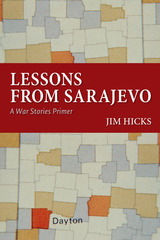 Lessons from Sarajevo: A War Stories Primer
Jim Hicks
University of Massachusetts Press, 2013 In today's world, our television screens are filled with scenes from countless conflicts across the globe—commanding our attention and asking us to choose sides. In this insightful and wide-ranging book, Jim Hicks treats historical representation, and even history itself, as a text, asking questions such as Who is speaking?, Who is the audience?, and What are the rules for this kind of talk? He argues that we must understand how war stories are told in order to arm ourselves against them. In a democracy, we are each responsible for policy decisions taken on our behalf. So it is imperative that we gain fluency in the diverse forms of representation (journalism, photography, fiction, memoir, comics, cinema) that bring war to us.
Hicks explores the limitations of the sentimental tradition in war representation and asks how the work of artists and writers can help us to move beyond the constraints of that tradition. Ranging from Walt Whitman's writings on the Civil War to the U.S. wars in Iraq and Afghanistan, and focusing on the innovative and creative artistic expressions arising out of the wars of the former Yugoslavia, Hicks examines how war has been perceived, described, and interpreted. He analyzes the limitations on knowledge caused by perspective and narrative position and looks closely at the distinct yet overlapping roles of victims, observers, and aggressors. In the end, he concludes, war stories today should be valued according to the extent they make it impossible for us to see these positions as assigned in advance, and immutable.
 Lessons from "Take Me Home, Country Roads": Identity, (Be)Longing, and Imagined Landscapes
Sarah L. Morris
West Virginia University Press, 2025 You may have heard it at a football game, in an advertisement, or on the radio on a road trip far from home. You may have sung along on a rooftop in Thailand, at Oktoberfest in Belgium, or with a Japanese cover band. It may have moved you to dance at a wedding or cry at a funeral. Regardless of where it plays, the song “Take Me Home, Country Roads” is ubiquitous, unmistakable, universal. Written and recorded by Bill Danoff, Taffy Nivert, and John Denver in 1971, the song continues to resonate across cultures and audiences, carrying meaning beyond naming and inviting transformation for a range of rhetorical purposes in nearly 300 recorded English versions and in more than 20 languages.
This book examines “Country Roads” as it illuminates a universal sense of belonging to place even as it obscures the literality of the place it names. In examining “Country Roads” as anthem, text, artifact, and rhetoric, this work untangles ideas related to place, belonging, identity, and pedagogy. Sarah L. Morris uses the Welsh term hiraeth, which is an existential longing for an idealized, sometimes imaginary home, as a governing framework for this work. She explores the song in various contexts, such as how it pertains to West Virginia geography and heritage and the diversity of these beliefs, external perceptions of the state, concepts of home and belonging, and the song as a phenomenon across different media platforms. “Take Me Home, Country Roads,” while being about West Virginia, has registered as a global phenomenon.
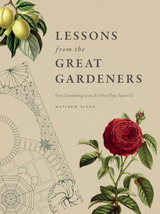 Lessons from the Great Gardeners: Forty Gardening Icons and What They Teach Us
Matthew Biggs
University of Chicago Press, 2016 Like heirloom seeds and grafts from trees, advice from great gardeners handed down through the centuries has shaped the science and art of gardens across the globe. Spanning gardeners from fifteenth-century Japan to the contemporary United States, Lessons from the Great Gardeners profiles forty groundbreaking botanists, nurserymen, and tillers of earth, men and women whose passion, innovation, and green thumbs endure in the formal landscapes and vegetable patches of today.
Entries for each gardening great highlight their iconic plants and garden designs, revealing both the gardeners’ own influences and the seeds—sometimes literal—that they sowed for gardens yet to sprout. From André Le Nôtre in seventeenth-century France, who drew on his training as an architect and hydraulic engineer to bring the topiary form to Vaux-le-Vicomte and Versailles, to the work of High Line and Lurie Garden designer Piet Oudolf, and Thomas Jefferson’s advice on creating protected garden microclimates for help growing early crops and tender fruit like figs (with peas, a Jefferson favorite), Lessons from the Great Gardeners is a resource as rich as the soil from which it springs.
Featuring lush illustrations harvested from the archives of the Royal Horticultural Society, as well as sections on a dozen international gardens that showcase the lessons of the greats, this homage to the love of good, clean dirt is sure to inspire readers to get out in the sun and dig.
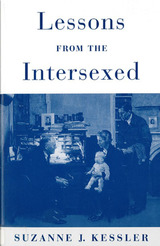 Lessons from the Intersexed
Kessler, Suzanne J
Rutgers University Press, 1998 From the moment intersexuality-the condition of having physical gender markers (genitals, gonads, or chromosomes) that are neither clearly female nor male-is suspected and diagnosed, social institutions are mobilized in order to maintain the two seemingly objective sexual categories. Infants' bodies are altered, and what was "ambiguous" is made "normal." Kessler's interviews with pediatric surgeons and endocrinologists reveal how the intersex condition is normalized for parents and she argues that the way in which intersexuality is managed by the medical and psychological professions displays our culture's beliefs about gender and genitals. Parents of intersexed children are rarely heard from, but in this book they provide another perspective on reasons for genital surgeries and the quality of medical and psychological management. Although physicians educate parents about how to think about their children's condition, Kessler learned from parents of intersexed children that some parents are able to accept atypical genitals. Based on analysis of the medical literature and interview with adults who had received treatment as interesexed children, Kessler proposes new approaches for physicians to use in talking with parents and children. She also evaluates the appearance of a politicized vanguard, many of who are promoting an intersexual identity, who seek to alter the way physicians respond to intersexuality. Kessler explores the possibilities and implications of suspending a commitment to two "natural" genders and addresses gender destabilization issues arising from intersexuality. She thus compels readers to re-think the meaning of gender, genitals, and sexuality.
"This is a brave book. Kessler says things that need to be said, and she says them clearly, concisely, and with respect for the people whose lives are most affected by the questions she confronts. A must read for anyone concerned with intersex issues." --Holly Devor, author of Gender Blending: Confronting the Limits of Duality and FTM: Female-to-Male Transsexuals in Society.
"While the physician's response to an infant with ambiguous genitalia has been to produce categories like the 'successful vagina' and the 'good enough penis,' Kessler takes her cues from intersexuals themselves. This book is a brilliant and long overdue call for the reevaluation of gender variability." --Judith Halberstam, author of Female Masculinity
"Fascinating in what it tells us not only about situation in which sex assignment is uncertain but about the astonishingly weak empirical foundations on which the medical orthodoxies of binary sex and gender are built. A must for anyone interested in the ways widely accepted social beliefs and scientific explanations generate and reinforce each other." --Ruth Hubbard, author of The Politics of Women's Biology and Exploding the Gene Myth
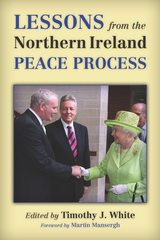 Lessons from the Northern Ireland Peace Process
Edited by Timothy J. White; Foreword by Martin Mansergh
University of Wisconsin Press, 2013 From the early 1970s through the mid-1990s, Northern Ireland was the site of bitter conflict between those struggling for reunification with the rest of Ireland and those wanting the region to remain a part of the United Kingdom. After years of strenuous negotiations, nationalists and unionists came together in 1998 to sign the Good Friday Agreement. Northern Ireland's peace process has been deemed largely successful. Yet remarkably little has been done to assess in a comprehensive fashion what can be learned from it. Lessons from the Northern Ireland Peace Process incorporates recent research that emphasizes the need for civil society and a grassroots approach to peacebuilding while taking into account a variety of perspectives, including neoconservatism and revolutionary analysis. The contributions, which include the reflections of those involved in the negotiation and implementation of the Good Friday Agreement, also provide policy prescriptions for modern conflicts. This collection of essays in Lessons from the Northern Ireland Peace Process fills a void by articulating the lessons learned and how—or whether—the peace processes can be applied to other regional conflicts.
Lessons from the Past: The Moral Use of History in Fourth-Century Prose
Frances Pownall
University of Michigan Press, 2003 Because of the didactic nature of the historical genre, many scholars ancient and modern have seen connections between history and rhetoric. So far, discussion has centered on fifth-century authors -- Herodotus and Thucydides, along with the sophists and early philosophers. Pownall extends the focus of this discussion into an important period. By focusing on key intellectuals and historians of the fourth century (Plato and the major historians -- Xenophon, Ephorus, and Theopompus), she examines how these prose writers created an aristocratic version of the past as an alternative to the democratic version of the oratorical tradition.
Frances Pownall is Professor of History and Classics, University of Alberta.
 Lessons in Censorship: How Schools and Courts Subvert Students’ First Amendment Rights
Catherine J. Ross
Harvard University Press, 2015 American public schools often censor controversial student speech that the Constitution protects. Lessons in Censorship brings clarity to a bewildering array of court rulings that define the speech rights of young citizens in the school setting. Catherine J. Ross examines disputes that have erupted in our schools and courts over the civil rights movement, war and peace, rights for LGBTs, abortion, immigration, evangelical proselytizing, and the Confederate flag. She argues that the failure of schools to respect civil liberties betrays their educational mission and threatens democracy.
From the 1940s through the Warren years, the Supreme Court celebrated free expression and emphasized the role of schools in cultivating liberty. But the Burger, Rehnquist, and Roberts courts retreated from that vision, curtailing certain categories of student speech in the name of order and authority. Drawing on hundreds of lower court decisions, Ross shows how some judges either misunderstand the law or decline to rein in censorship that is clearly unconstitutional, and she powerfully demonstrates the continuing vitality of the Supreme Court’s initial affirmation of students’ expressive rights. Placing these battles in their social and historical context, Ross introduces us to the young protesters, journalists, and artists at the center of these stories.
Lessons in Censorship highlights the troubling and growing tendency of schools to clamp down on off-campus speech such as texting and sexting and reveals how well-intentioned measures to counter verbal bullying and hate speech may impinge on free speech. Throughout, Ross proposes ways to protect free expression without disrupting education.
 Lessons in Drag: A Queer Manual for Academics, Artists, and Aunties
Kareem Khubchandani with LaWhore Vagistan
Brandeis University Press, 2025 Scholarship and performance combine to show how drag can be a blueprint for critique, care, teaching, and worldmaking.
Lessons in Drag brings to life a vibrant and thought-provoking dialogue between scholar Kareem Khubchandani and his drag persona LaWhore Vagistan. Beginning with an intimate interview, the book unfolds in alternating chapters where the two exchange insights, stories, and critiques. Khubchandani delves into the lessons LaWhore’s drag practice offers about academia—shaping his approaches to research, teaching, and writing—while Vagistan reveals how Khubchandani’s scholarship influences her performances, inspiring her understanding of fashion, music, divas, and aunties. Together, their reflections and conversations weave a compelling tapestry of drag’s instructive power. Witty, bold, and deeply personal, Lessons in Drag is both an invitation to explore drag as a practice and a celebration of its transformative potential.
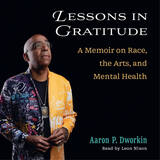 Lessons in Gratitude: A Memoir on Race, the Arts, and Mental Health
Aaron P. Dworkin
University of Michigan Press, 2024 Lessons in Gratitude tells the story of Aaron Dworkin, a MacArthur Fellow, social entrepreneur, and spoken word artist who has dedicated his life’s work to changing the face of classical arts in the world. The themes of persistence, passion, and loyalty shine through stories of an unhappy childhood, a lifelong search for identity, and the obstacles of race, culture, and class. Readers will learn how the author greets these challenges and how they drove him to make a difference for people who are shut out of opportunity. Persistence in the face of multiple failures and false starts ultimately led Dworkin to create the Sphinx Organization, whose mission is to address the underrepresentation of Black and Latino people in the field of the classical arts.
Aaron’s unique journey, which begins with his adoption by a white Jewish couple from Chicago at two weeks of age, leads him to the ultimate reunification with his birth family at the age of 31. Lessons in Gratitude is a coming of age story that examines the difficulties of biracial identity across generations and the challenges that mixed race families still face today. It is also a painful and honest adoption memoir, further complicating the narrator’s experiences of racial identity throughout his life and shaping his experiences with his own children. Through his work in the arts and the impact of this work, Dworkin has been able to “pay forward” the first thing that offered him unconditional love—music.
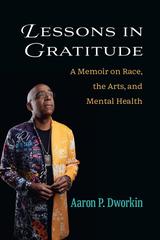 Lessons in Gratitude: A Memoir on Race, the Arts, and Mental Health
Aaron P. Dworkin
University of Michigan Press, 2024 Lessons in Gratitude tells the story of Aaron Dworkin, a MacArthur Fellow, social entrepreneur, and spoken word artist who has dedicated his life’s work to changing the face of classical arts in the world. The themes of persistence, passion, and loyalty shine through stories of an unhappy childhood, a lifelong search for identity, and the obstacles of race, culture, and class. Readers will learn how the author greets these challenges and how they drove him to make a difference for people who are shut out of opportunity. Persistence in the face of multiple failures and false starts ultimately led Dworkin to create the Sphinx Organization, whose mission is to address the underrepresentation of Black and Latinx people in the field of the classical arts.
Aaron’s unique journey, which begins with his adoption by a white Jewish couple from Chicago at two weeks of age, leads him to the ultimate reunification with his birth family at the age of 31. Lessons of Gratitude is a coming of age story that examines the difficulties of biracial identity across generations and the challenges that mixed race families still face today. It is also a painful and honest adoption memoir, further complicating the narrator’s experiences of racial identity throughout his life and shaping his experiences with his own children. Through his work in the arts and the impact of this work, Dworkin has been able to “pay forward” the first thing that offered him unconditional love—music.
Lessons in Laughter: The Autobiography of a Deaf Actor
Bernard Bragg
Gallaudet University Press, 1989 To succeed as an actor is a rare feat. To succeed as a deaf actor is nothing short of amazing. Lessons in Laughter is the story of Bernard Bragg and his astonishing lifelong achievements in the performing arts. Born deaf of deaf parents, Bernard Bragg has won international renown as an actor, director, playwright, and lecturer. Lessons in Laughter recounts in stories that are humorous, painful, touching, and outrageous, the growth of his dream of using the beauty of sign language to act. He starred in his own television show “The Quiet Man,” helped found The National Theatre of the Deaf, and traveled worldwide to teach his acting methods.
Lessons in Leadership
Steve Adubato, PhD
Rutgers University Press, 2016 In this practical guide, Emmy Award-winning public broadcasting anchor Steve Adubato teaches readers to be self-aware, empathetic, and more effective leaders at work and at home. His powerful case studies spotlighting dozens of leaders—from Pope Francis to New Jersey governor Chris Christie—are complemented by concrete tips and tools based in real-life scenarios. With Lessons in Leadership, readers can learn to steer others through difficult economic times, to mentor rising leaders, to provide straight talk to underperforming employees, and even how to lead a company through a significant change.
Lessons in Modern Hebrew: Level 1
Edna Amir Coffin
University of Michigan Press, 1977 A comprehensive introduction to modern Israeli Hebrew, Lessons in Modern Hebrew: Level I and Level II provide English-speaking students and well-motivated individuals with all the basic classroom tools necessary for mastery of the language. The lessons introduce the student to the core vocabulary which is then included in reading passages, conversational text, and written communication. All grammatical features of modern Hebrew are thoroughly explained and reinforced by drills and exercises. The books have been classroom-tested at the University of Michigan. Both audio-lingual and cognitive approaches are used.
Lessons in Modern Hebrew: Level 2
Edna Amir Coffin
University of Michigan Press, 1978 A comprehensive introduction to modern Israeli Hebrew, Lessons in Modern Hebrew: Level I and Level II provide English-speaking students and well-motivated individuals with all the basic classroom tools necessary for mastery of the language. The lessons introduce the student to the core vocabulary which is then included in reading passages, conversational text, and written communication. All grammatical features of modern Hebrew are thoroughly explained and reinforced by drills and exercises. The books have been classroom-tested at the University of Michigan. Both audio-lingual and cognitive approaches are used. Cassettes are available from the University of Michigan Language Resource Center: Phone: (734) 764-0424; Email: lrc.contact@umich.edu.
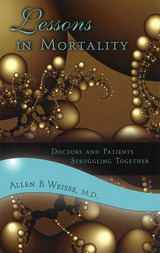 Lessons in Mortality: Doctors and Patients Struggling Together
Allen B. Weisse, M.D.
University of Missouri Press, 2006
It doesn’t take a trip to the doctor to know that the bond between physicians and patients isn’t what it used to be. Specialization, rising costs, managed care, the insurance industry, the shadow of litigation—so many factors have changed what was once a traditional relationship grounded in respect and caring.
In light of the altered climate in health care, this thoughtful book deals with the way that today’s doctors and patients view themselves and one another. Allen Weisse has observed the changing medical scene during half a century of treating patients and training future physicians, and he writes frankly here about how doctors and patients have come to deal with illness in the twenty-first century.
Weisse first recalls his own brush with death as a young man diagnosed with testicular cancer—a time when one thinks of God and Death and little else. He then shares true stories of how different people have dealt with cancer, heart disease, stroke, infectious disease, AIDS, and other dire diagnoses—narratives enhanced by professional savvy and enriched by the kind of empathy that the survivor of such a calamity can provide.
Drawing from a storehouse of experiences shared by colleagues, patients, and friends, Weisse writes with passion, conviction, and clarity to encourage a renewal of the openness and trust that seem to be lacking in today’s doctor-patient relationships. These are accounts both uplifting and disturbing—some sad, others tinged with humor—intended to make doctors and patients alike come to a fuller realization that we are all together in this delicate but crucial business of staying alive.
While not quite foreseeing a return to the Norman Rockwell image of the family physician, Weisse urges the kind of care and compassion that patients often feel is lacking from their doctors, and he reassures victims of seemingly hopeless conditions that, despite the obstacles they often face, there are still health care professionals who truly have their patients’ welfare foremost in mind. Lessons in Mortality is just what the doctor ordered for a health care system in crisis: an honest look at the medical profession that encourages greater understanding on the part of both physicians and patients, reminding us that what we most need is one another.
 Lessons Inspired by Picture Books for Primary Grades
Maureen Schlosser
American Library Association, 2019 Drawing on compelling picture books that can be used to directly support the AASL National School Library Standards for Learners, School Librarians, and School Libraries, this ready-to-go toolkit of lessons, worksheets, anchor charts, assessments, and rubrics is specifically designed to build learner competencies while examining big ideas inspired by picture books. An invaluable timesaver, this resource provides - 21 lesson units that cover the six Shared Foundations, each utilizing a formatted template that’s easy to follow and incorporates the four Domains (Think, Create, Share, Grow);
- a picture book synopsis for each unit, followed by lesson objectives, essential questions, materials, and duration;
- worksheets, anchor charts, and exit slips tailored for each picture book and lesson;
- “Quick Tips” that offer helpful ideas and suggestions to consider during the lesson; and
- an appendix that includes rubrics to facilitate assessment in all six foundations.
 Lessons of Disaster: Policy Change after Catastrophic Events
Thomas A. Birkland
Georgetown University Press, 2006 Even before the wreckage of a disaster is cleared, one question is foremost in the minds of the public: "What can be done to prevent this from happening again?" Today, news media and policymakers often invoke the "lessons of September 11" and the "lessons of Hurricane Katrina." Certainly, these unexpected events heightened awareness about problems that might have contributed to or worsened the disasters, particularly about gaps in preparation. Inquiries and investigations are made that claim that "lessons" were "learned" from a disaster, leading us to assume that we will be more ready the next time a similar threat looms, and that our government will put in place measures to protect us. In Lessons of Disaster, Thomas Birkland takes a critical look at this assumption. We know that disasters play a role in setting policy agendas—in getting policymakers to think about problems—but does our government always take the next step and enact new legislation or regulations? To determine when and how a catastrophic event serves as a catalyst for true policy change, the author examines four categories of disasters: aviation security, homeland security, earthquakes, and hurricanes. He explores lessons learned from each, focusing on three types of policy change: change in the larger social construction of the issues surrounding the disaster; instrumental change, in which laws and regulations are made; and political change, in which alliances are created and shifted.
Birkland argues that the type of disaster affects the types of lessons learned from it, and that certain conditions are necessary to translate awareness into new policy, including media attention, salience for a large portion of the public, the existence of advocacy groups for the issue, and the preexistence of policy ideas that can be drawn upon. This timely study concludes with a discussion of the interplay of multiple disasters, focusing on the initial government response to Hurricane Katrina and the negative effect the September 11 catastrophe seems to have had on reaction to that tragedy.
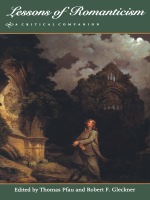 Lessons of Romanticism: A Critical Companion
Thomas Pfau and Robert F. Gleckner, eds.
Duke University Press, 1998 Moving beyond views of European Romanticism as an essentially poetic development, Lessons of Romanticism strives to strengthen a critical awareness of the genres, historical institutions, and material practices that comprised the culture of the period. This anthology—in recasting Romanticism in its broader cultural context—ranges across literary studies, art history, musicology, and political science and combines a variety of critical approaches, including gender studies, Lacanian analysis, and postcolonial studies. With over twenty essays on such diverse topics as the aesthetic and pedagogical purposes of art exhibits in London, the materiality of late Romantic salon culture, the extracanonical status of Jane Austen and Fanny Burney, and Romantic imagery in Beethoven’s music and letters, Lessons of Romanticism reveals the practices that were at the heart of European Romantic life. Focusing on the six decades from 1780 to 1832, this collection is arranged thematically around gender and genre, literacy, marginalization, canonmaking, and nationalist ideology. As Americanists join with specialists in German culture, as Austen is explored beside Beethoven, and as discussions on newly recovered women’s writings follow fresh discoveries in long-canonized texts, these interdisciplinary essays not only reflect the broad reach of contemporary scholarship but also point to the long-neglected intertextual and intercultural dynamics in the various and changing faces of Romanticism itself. Contributors. Steven Bruhm, Miranda J. Burgess, Joel Faflak, David S. Ferris, William Galperin, Regina Hewitt, Jill Heydt-Stevenson, H. J. Jackson, Theresa M. Kelley, Greg Kucich, C. S. Matheson, Adela Pinch, Marc Redfield, Nancy L. Rosenblum, Marlon B. Ross, Maynard Solomon, Richard G. Swartz, Nanora Sweet, Joseph Viscomi, Karen A. Weisman, Susan I. Wolfson
 Lessons of the Masters
George Steiner
Harvard University Press, 2003 “Trenchant and moving.”—Robert Boyers, Los Angeles Times
The inexhaustible man of letters directs his critical gaze at his own profession—teaching.
When we talk about education today, we tend to avoid the rhetoric of “mastery,” with its erotic and inegalitarian overtones. But the charged personal encounter between master and disciple is precisely what interests George Steiner in this book, a sustained reflection on the infinitely complex and subtle interplay of power, trust, and passions in the most profound sorts of pedagogy. Based on Steiner's 2001–2002 Norton Lectures on the art and lore of teaching, Lessons of the Masters evokes a host of exemplary figures, including Socrates and Plato, Virgil and Dante, Heloise and Abelard, Tycho Brahe and Johannes Kepler, Edmund Husserl and Martin Heidegger, along with spiritual leaders from Buddhist and Confucian sages to Jesus and the Baal Shem Tov.
Pivotal in the unfolding of Western culture are Socrates and Jesus, charismatic masters who left no written teachings and founded no schools. In the efforts of their disciples—and in the passion narratives inspired by their deaths—Steiner sees the beginnings of the inward vocabulary, the encoded recognitions of much of our moral, philosophical, and theological idiom. He goes on to consider a diverse array of traditions and disciplines, returning throughout to three underlying themes: the master's power to exploit his student's dependence and vulnerability; the complementary threat of subversion and betrayal of the mentor by his pupil; and the reciprocal exchange of trust and love, of learning and instruction between master and disciple.
Forcefully written and passionately argued, Lessons of the Masters is itself a masterly testament to the high vocation and perilous risks undertaken by true teacher and learner alike.
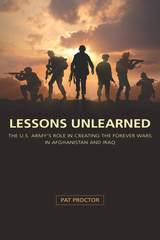 Lessons Unlearned: The U.S. Army's Role in Creating the Forever Wars in Afghanistan and Iraq
Pat Proctor
University of Missouri Press, 2020 Colonel Pat Proctor’s long overdue critique of the Army’s preparation and outlook in the all-volunteer era focuses on a national security issue that continues to vex in the twenty-first century: Has the Army lost its ability to win strategically by focusing on fighting conventional battles against peer enemies? Or can it adapt to deal with the greater complexity of counterinsurgent and information-age warfare?
In this blunt critique of the senior leadership of the U.S. Army, Proctor contends that after the fall of the Soviet Union, the U.S. Army stubbornly refused to reshape itself in response to the new strategic reality, a decision that saw it struggle through one low-intensity conflict after another—some inconclusive, some tragic—in the 1980s and 1990s, and leaving it largely unprepared when it found itself engaged—seemingly forever—in wars in Afghanistan and Iraq. The first book-length study to connect the failures of these wars to America’s disastrous performance in the war on terror, Proctor’s work serves as an attempt to convince Army leaders to avoid repeating the same mistakes.
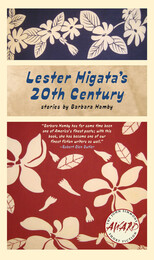 Lester Higata's 20th Century
Barbara Hamby
University of Iowa Press, 2010 “Lester Higata knew his life was about to end when he walked out on the lanai behind his house in Makiki and saw his long-dead father sitting in a lawn chair near the little greenhouse where Lester kept his orchids.” Thus begins Barbara Hamby’s magical narrative of the life of a Japanese American man in Honolulu. The quietly beautiful linked stories in Lester Higata’s 20th Century bring us close to people who could be, and should be, our friends and neighbors and families. Starting in 1999 with his conversation with his father, continuing backward in time throughout his life with his wife, Katherine, and their children in Hawai‘i, and ending with his days in the hospital in 1946, as he heals from a wartime wound and meets the woman he will marry, Hamby recreates not just one but any number of the worlds that have shaped Lester. The world of his mother, as stubbornly faithful to Japan and Buddhism as Katherine’s mother is to Ohio and conservative Christianity; the world of his children, whose childhoods and adulthoods are vastly different from his own; the world after Pearl Harbor and Vietnam; the world of a professional engineer and family man: the worlds of Lester Higata’s 20th Century are filled with ordinary people living extraordinary lives, moving from farms to classrooms and offices, from racism to acceptance and even love, all in a setting so paradisal it should be heaven on earth. Never forgetting the terrors of wartime—“We wake one morning with the wind racing toward us like an animal, and nothing is ever the same”—but focusing on the serene joys of peacetime, Lester populates his worlds with work, faith, and family among the palm trees and blue skies of the island he loves.
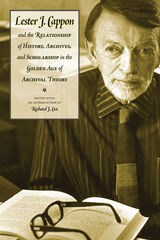 Lester J. Cappon and the Relationship of History, Archives, and Scholarship
Richard J. Cox
Society of American Archivists, 2004 The relationship of history, archival studies, and the emergent information disciplines continues to be a topic of debate in the modern archival profession. Lester J. Cappon (1900-1981) is the quintessential proponent of archival knowledge based on historical scholarship, and his writings remain prescient decades after his death, writes Richard J. Cox in his excellent introduction.
The 12 essays collected for the first time in a single volume cover the range of Cappon's primary interests: archival theory, archival collecting and appraisal, the relationship between archivists and historians or archives and history, and documentary editing. These essays, which reflect Cappon's considerable soul searching about the knowledge and identity of the archivist, and his own strong sense of history and archives, continue to be relevant today and make an important contribution to the professional discourse.
Lester Young
Lewis Porter
University of Michigan Press, 2005 Praise for Lester Young:
". . . a schematic of unparalleled insight and detail."
---Down Beat
"A monumental work."
---Dizzy Gillespie
". . . a major contribution to jazz scholarship . . . for its illumination of Lester Young's music and for setting the biographical record straight."
---Dan Morgenstern
Several new biographies of Lester Young have been published in the years since Lewis Porter's Lester Young first appeared, but none have supplanted or even attempted the in-depth study that Porter brings to his subject's music. With the same care and scholarship that characterized his John Coltrane, Porter analyzes the music that made Lester Young "the most original tenor sax in jazz."
In addition to helping us understand Lester Young's playing and stylistic evolution, Porter's analysis demonstrates that Young's playing at the end of his career did not mark a serious decline over his earlier style, as many critics have claimed.
 Let Burn
Rachel K. Wentz
Michigan State University Press, 2013 In 1985, desiring a meaningful, high-paced career in public service, Rachel Wentz left her university studies to become a firefighter/paramedic. Only the eighth woman hired by the Orlando Fire Department, a highly competitive department steeped in tradition, Wentz excelled, completing an AS in Fire Science, a master’s in public administration, and numerous specialized training courses to prepare her for an administrative position within the department. Wentz spent eleven years with OFD, experiencing a career that was every bit as exciting and challenging as she had sought. A moving, candid, and eloquent memoir, Let Burn recounts her experiences as a firefighter/paramedic, during which time she witnessed aspects of life and death few people are privy to, experiences that shaped her as a professional and as a person. From the rigorous demands of training to the extraordinary calls Wentz responded to, Let Burn details the gratifying aspects of the field, but also demonstrates the precarious nature of the job: a heated altercation at the scene of an industrial fire leads to Wentz losing almost everything she’s worked for and the dramatic end of a storied career. In vivid detail, Let Burn provides a firsthand glimpse into the hidden world of firefighting and emergency medicine.
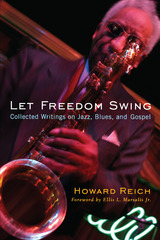 Let Freedom Swing: Collected Writings on Jazz, Blues, and Gospel
Howard Reich
Northwestern University Press, 2010 A swing note is, to the listener of the rhythm, an unexpected note, and it is the spark of life in jazz and its relatives. Whether playing the standards or the most experimental piece, it is how a musician handles these notes—fearlessly or safely—that determines the fate of the performance. Howard Reich’s critical writing is similarly unexpected and fearless, and Let Freedom Swing is a collection of the articles from the past three decades that best capture this spirit.
Each section of Let Freedom Swing composes a suite, focusing on either a person, place, or scene. Reich gives new life to the standards with his profiles and elegies for such giants as Gershwin, Ellington, and Sinatra. A profile of Louis Armstrong brings out the often angry side of Satchmo but also reveals a more remarkable musician and human being.
His open-mindedness makes Reich a particularly astute observer of the experimental and new, from Ornette Coleman to Chicago experimentalist Ken Vandermark. And his observations about street music open our ears to the songs of everyday life. Reich’s fearlessness is evident in his writing about daunting subjects, such as the New Orleans music scene after Katrina, the lost legacy of jazz in Panama, and the complicated legacy of "race music" in America.
Howard Reich combines a deep enthusiasm for music, a breadth of knowledge, and an ability to share his world with his readers, and Let Freedom Swing is essential reading for anyone interested in the continuing vitality of jazz, gospel, blues, and American music in general.
Let It Be Broke
Ed Pavlic
Four Way Books, 2020 The poems in Ed Pavlić’s Let It Be Broke are ignited by sonic memories—from Chaka Khan on the radio to his teenaged daughter singing “Stay” at a local café—that spark a journey into personal and ontological questions. Pavlić’s lyric lines are equal parts introspection and inter-spection, a term he coins for the shared rumination that encourages some collective deep thinking about the arbitrary boundaries that perpetuate racial and geographic segregation and the power of words to transcend those differences. In an epiphanic moment, Pavlić recalls a quote shared by a former teacher as “a hammer made of written words,” and how he held “onto those words / as if they were steel bars and I was dangling over some bright black deepness.”
 Let Jasmine Rain Down: Song and Remembrance among Syrian Jews
Kay Kaufman Shelemay
University of Chicago Press, 1998 When Jews left Aleppo, Syria, in the early twentieth century and established communities abroad, they carried with them a repertory of songs (pizmonim) with sacred Hebrew texts set to melodies borrowed from the popular Middle Eastern Arab musical tradition. Let Jasmine Rain Down tells the story of the pizmonim as they have continued to be composed, performed, and transformed through the present day; it is thus an innovative ethnography of an important Judeo-Arabic musical tradition and a probing contribution to studies of the link between collective memory and popular culture.
Shelemay views the intersection of music, individual remembrances, and collective memory through the pizmonim. Reconstructing a century of pizmon history in America based on research in New York, Mexico, and Israel, she explains how verbal and musical memories are embedded in individual songs and how these songs perform both what has been remembered and what otherwise would have been forgotten. In confronting issues of identity and meaning in a postmodern world, Shelemay moves ethnomusicology into the domain of memory studies.
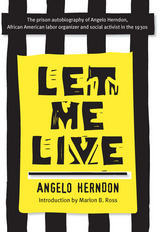 Let Me Live
Angelo Herndon
University of Michigan Press, 2007 Let Me Live tells the remarkable story of Angelo Herndon, a coal miner who worked as a labor organizer in Alabama and Georgia in the 1930s. Herndon led a racially integrated march of the unemployed in 1932 and was subsequently arrested when Communist Party literature was found in his bedroom. His trial made only small headlines at first, but eventually an international campaign to free him emerged, thanks to the efforts of the Communist Party and of labor unions interested in protecting the right to organize in the South. Herndon was finally set free by the U.S. Supreme Court, with the help of well-known leaders including C. Vann Woodward, Thurgood Marshall, A. Philip Randolph, and Whitney North Seymour, Sr. Written while Herndon was in prison, Let Me Live tells the story behind his arrest and his struggle through the courts. It also describes his early life as a young boy in poverty, as a laborer in the Kentucky mines, and as a construction gang worker and traces the birth and development of his passion for the Communist Party. Originally published in 1937, this is the first new edition of Let Me Live since 1969, when Howard N. Meyer rescued it from obscurity. The book features texts from the Georgia and U.S. Supreme Court decisions, the text of Herndon’s speech, and newspaper editorials from the era. A substantive and thought-provoking introduction by Marlon B. Ross of the University of Virginia sheds light on this unique story and its importance to our understanding of the intersection of race and class in America—past and present. “A book which every thoughtful American may do well to read. It is moving and challenging as the story of one man’s life and the question of one man’s fate.” —New York Times
Let Me See It: Stories
James Magruder
Northwestern University Press, 2014 James Magruder’s collection of linked stories follows two gay cousins, Tom and Elliott, from adolescence in the 1970s to adulthood in the early ’90s. With a rueful blend of comedy and tenderness, Magruder depicts their attempts to navigate the closet and the office and the lessons they learn about libidinous coworkers, résumé boosting, Italian suffixes, and frozen condoms. As Tom and Elliot search for trusting relationships while the AIDS crisis deepens, their paths diverge, leading Tom to a new sense of what matters most. Magruder is especially adept at rendering the moments that reveal unwritten codes of behavior to his characters, who have no way of learning them except through painful experience. Loss is sudden, the fallout portrayed with a powerful economy. In Tom and Elliott, readers come to recognize themselves, driven by the same absurd desires and unconscious impulses, subjected to the same fates.
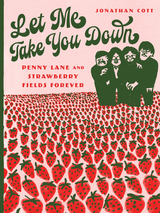 Let Me Take You Down: Penny Lane and Strawberry Fields Forever
Jonathan Cott
University of Minnesota Press, 2024 The conception, creation, recording, and significance of the Beatles’ “Penny Lane” and “Strawberry Fields Forever” John Lennon wrote “Strawberry Fields Forever” in Almería, Spain, in fall 1966, and in November, in response to that song, Paul McCartney wrote “Penny Lane” at his home in London. A culmination of what was one of the most life-altering and chaotic years in the Beatles’ career, these two songs composed the 1967 double A-side 45 rpm record that has often been called the greatest single in the history of popular music and was, according to Beatles producer George Martin, “the best record we ever made.” In Let Me Take You Down: Penny Lane and Strawberry Fields Forever, Jonathan Cott recounts the conception and creation of these songs; describes the tumultuous events and experiences that led the Beatles to call it quits as a touring band and redefine themselves solely as recording artists; and details the complex, seventy-hour recording process that produced seven minutes of indelible music. In writing about these songs, he also focuses on them as inspired artistic expressions of two unique ways of experiencing and being in the world, as Lennon takes us down to Strawberry Fields and McCartney takes us back to Penny Lane. In order to gain new vistas and multiple perspectives on these multifaceted songs, Cott also engages in conversation with five remarkable people: media artist Laurie Anderson; guitarist Bill Frisell; actor Richard Gere; Jungian analyst Margaret Klenck; and urban planner, writer, and musician Jonathan F. P. Rose. The result is a wide-ranging, illuminating exploration of the musical, literary, psychological, cultural, and spiritual aspects of two of the most acclaimed songs in rock and roll history.
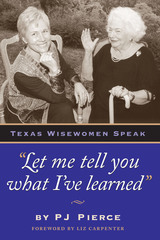 Let me tell you what I've learned: Texas Wisewomen Speak
By PJ Pierce
University of Texas Press, 2002 Barbara Jordan spoke for many Texas women when she told a reporter, "I get from the soil and spirit of Texas the feeling that I, as an individual, can accomplish whatever I want to, and that there are no limits, that you can just keep going, just keep soaring. I like that spirit." Indeed, the sense of limitless possibilities has inspired countless Texas women—sometimes in the face of daunting obstacles—to build lives rich in work, family, friends, faith, and community involvement. In this collection of interviews conducted by PJ Pierce, twenty-five Texas women ranging in age from 53 to 93 share the wisdom they've acquired through living unconventional lives. Responding to the question "What have you found that really matters about life?" they offer keen insights into motherhood, career challenges, being a minority, marriage and widowhood, anger, assertiveness, managing change, persevering, power, speaking out, fashioning success from failure, writing your own job description, loving a younger man, and recognizing opportunities disguised as disaster—to name only a few of their topics. In her introduction, Pierce describes how she came to write the book and how she chose her subjects to represent a cross-section of career paths and ethnic groups and all geographic areas of Texas. A topical index makes it easy to compare several women's views on a given subject.
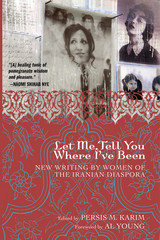 Let Me Tell You Where I've Been: New Writing by Women of the Iranian Diaspora
Persis M. Karim
University of Arkansas Press, 2006 Until recently, Iranian literature has overwhelmingly been the domain of men. But the new hybrid culture of diaspora Iranians has produced a prolific literature by women that reflects a unique perspective and voice. Let Me Tell You Where I've Been is an extensive collection of poetry, fiction, and nonfiction by women whose lives have been shaped and influenced by Iran's recent history, exile, immigration and the formation of new cultural identities in the United States and Europe. These writings represent an emerging and multi-cultural female sensibility. Unlike many flat media portrayals of Iranian women—as veiled, silenced—these writers offer a complex literary view of Iranian culture and its influences. These writers interrogate, challenge, and re-define notions of home and language and their work offers readers an experience of Iranian diaspora culture. Featuring over one hundred selections (two-thirds of which have never been published before) by more than fifty contributors--including such well-known writers as Gelareh Asayesh, Tara Bahrampour, Firoozeh Dumas, Roya Hakakian and Mimi Khalvati--the collection represents a substantial diversity of voices in this multicultural community. Divided into six sections, the book's themes of exile, family, culture resistance, and love, create a rich and textured view of the Iranian diaspora. The poems, short stories, and essays are suggestive of an important conversation about Iran, Iranian culture, the Persian and English languages, and the dual identities of many of its authors. This powerful collection is a tribute to the wisdom, insight, and sensitivity of women attempting to invent and articulate a literature of in-betweenness.
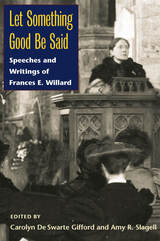 Let Something Good Be Said: Speeches and Writings of Frances E. Willard
Frances E. Willard. Edited by Carolyn De Swarte Gifford and Amy R. Slagell
University of Illinois Press, 2007 The definitive collection of speeches and writings of one of America's most important social reformers Celebrated as the most famous woman in America at the time of her death in 1898, Frances E. Willard was a leading nineteenth-century American temperance and women's rights reformer and a powerful orator. President of Evanston College for Ladies (before it merged with Northwestern University) and then professor of rhetoric and aesthetics and the first dean of women at Northwestern, Willard is best known for leading the Woman's Christian Temperance Union (WCTU), America's largest women's organization. The WCTU shaped both domestic and international opinion on major political, economic, and social reform issues, including temperance, women's rights, and the rising labor movement. In what Willard regarded as her most important and far-reaching reform, she championed a new ideal of a powerful, independent womanhood and encouraged women to become active agents of social change. Willard's reputation as a powerful reformer reached its height with her election as president of the National Council of Women in 1888. This definitive collection follows Willard's public reform career, providing primary documents as well as the historical context necessary to clearly demonstrate her skill as a speaker and writer who addressed audiences as diverse as political conventions, national women's organizations, teen girls, state legislators, church groups, and temperance advocates. Including Willard's representative speeches and published writings on everything from temperance and women's rights to the new labor movement and Christian socialism, Let Something Good Be Said is the first volume to collect the messages of one of America's most important social reformers who inspired a generation of women to activism.
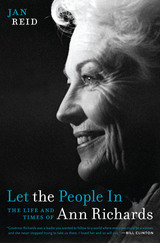 Let the People In: The Life and Times of Ann Richards
By Jan Reid
University of Texas Press, 2012 Winner, Coral Horton Tullis Memorial Prize, Texas State Historical Association, 2012
Liz Carpenter Award for Research in the History of Women, Texas State Historical Association, 2012 When Ann Richards delivered the keynote of the 1988 Democratic National Convention and mocked President George H. W. Bush—“Poor George, he can’t help it. He was born with a silver foot in his mouth”—she instantly became a media celebrity and triggered a rivalry that would alter the course of American history. In 1990, Richards won the governorship of Texas, upsetting the GOP’s colorful rancher and oilman Clayton Williams. The first ardent feminist elected to high office in America, she opened up public service to women, blacks, Hispanics, Asian Americans, gays, and the disabled. Her progressive achievements and the force of her personality created a lasting legacy that far transcends her rise and fall as governor of Texas. In Let the People In, Jan Reid draws on his long friendship with Richards, interviews with her family and many of her closest associates, her unpublished correspondence with longtime companion Bud Shrake, and extensive research to tell a very personal, human story of Ann Richards’s remarkable rise to power as a liberal Democrat in a conservative Republican state. Reid traces the whole arc of Richards’s life, beginning with her youth in Waco, her marriage to attorney David Richards, her frustration and boredom with being a young housewife and mother in Dallas, and her shocking encounters with Lyndon Johnson and Jimmy Carter. He follows Richards to Austin and the wild 1970s scene and describes her painful but successful struggle against alcoholism. He tells the full, inside story of Richards’s rise from county office and the state treasurer’s office to the governorship, where she championed gun control, prison reform, environmental protection, and school finance reform, and he explains why she lost her reelection bid to George W. Bush, which evened his family’s score and launched him toward the presidency. Reid describes Richards’s final years as a world traveler, lobbyist, public speaker, and mentor and inspiration to office holders, including Hillary Clinton. His nuanced portrait reveals a complex woman who battled her own frailties and a good-old-boy establishment to claim a place on the national political stage and prove “what can happen in government if we simply open the doors and let the people in.”
Let the People Judge: Wise Use And The Private Property Rights Movement
Edited by John Echeverria and Raymond Booth Eby; The Wilderness Society
Island Press, 1995 One of the most serious challenges to environmentalism that has emerged in the 1990s is the so-called Wise Use movement. While operating under the guise of an independent movement of small landowners, it is in reality a backlash against environmental protection measures, funded and organized by corporations with a vested interest in preventing further environmental gains. Let the People Judge collects the writings of a wide range of thinkers on the Wise Use movement and the controversies that fuel the Wise Use debate.
Let Them Eat Junk: How Capitalism Creates Hunger and Obesity
Robert Albritton
Pluto Press, 2009 Respected economist Robert Albritton argues that the capitalist system, far from delivering on the promise of cheap, nutritious food for all, has created a world where 25% of the world population are over-fed and 25% are hungry. This malnourishment of 50% of the world's population is explained systematically, a refreshing change from accounts that focus on cultural factors and individual greed. Albritton details the economic relations and connections that have put us in a situation of simultaneous oversupply and undersupply of food.
This explosive book provides yet more evidence that the human cost of capitalism is much bigger than those in power will admit.
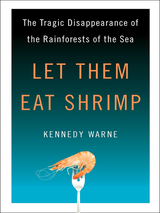 Let Them Eat Shrimp: The Tragic Disappearance of the Rainforests of the Sea
Kennedy Warne
Island Press, 2011 What’s the connection between a platter of jumbo shrimp at your local restaurant and murdered fishermen in Honduras, impoverished women in Ecuador, and disastrous hurricanes along America’s Gulf coast? Mangroves. Many people have never heard of these salt-water forests, but for those who depend on their riches, mangroves are indispensable. They are natural storm barriers, home to innumerable exotic creatures—from crabeating vipers to man-eating tigers—and provide food and livelihoods to millions of coastal dwellers. Now they are being destroyed to make way for shrimp farming and other coastal development. For those who stand in the way of these industries, the consequences can be deadly.
In Let Them Eat Shrimp, Kennedy Warne takes readers into the muddy battle zone that is the mangrove forest. A tangle of snaking roots and twisted trunks, mangroves are often dismissed as foul wastelands. In fact, they are supermarkets of the sea, providing shellfish, crabs, honey, timber, and charcoal to coastal communities from Florida to South America to New Zealand. Generations have built their lives around mangroves and consider these swamps sacred.
To shrimp farmers and land developers, mangroves simply represent a good investment. The tidal land on which they stand often has no title, so with a nod and wink from a compliant official, it can be turned from a public resource to a private possession. The forests are bulldozed, their traditional users dispossessed.
The true price of shrimp farming and other coastal development has gone largely unheralded in the U.S. media. A longtime journalist, Warne now captures the insatiability of these industries and the magic of the mangroves. His vivid account will make every reader pause before ordering the shrimp.
 Let Them Go Free: A Guide to Withdrawing Life Support
Thomas A. Shannon and Charles N. Faso, OFM
Georgetown University Press, 2007 Let Them Go Free offers families a way to cope with a problem particular to our time: what to do when medical treatment sustains life but does not cure or resuscitate a critically ill loved one. This straightforward and empathic guide helps such families affirm that their choice to remove life support is morally acceptable, warranted, and made in the spirit of love and care for the patient. With an emphasis on maintaining openness and trust among all involved in the decision-making process, this helpful guide skillfully addresses the questions that must be asked to assess the best course of care for a loved one: • What is the patient’s medical condition? • What are the medical options? • Has the patient expressed any wishes regarding his or her treatment? • What if the patient hasn’t expressed any wishes regarding treatment? • Do we have to do everything possible to keep the patient alive? • Do we have to use artificial means of feeding? • How do we handle disagreements? • What should we do about donating organs? Let Them Go Free also includes an ecumenical prayer service to be conducted as life support is withdrawn. Woven with readings and prayers from Hebrew and Christian scripture, the service is intended to give family and friends a moment to express their love for the patient, to say goodbye, and to find a sense of closure as they embark on the first stage of the grieving process.
Let There Be Night: Testimony on Behalf of the Dark
Paul Bogard
University of Nevada Press, 2008 The development of the modern world has brought with it rampant light pollution, destroying the ancient mystery of night and exacting a terrible price--wasted energy, damage to human health, and the sometimes fatal interruption of the life patterns of many species of wildlife. In Let There Be Night, twenty-nine writers, scientists, poets, and scholars share their personal experiences of night and help us to understand what we miss when dark skies and nocturnal wildness vanish. They also propose ways by which we might restore the beneficence of true night skies to our cities and our culture. Let There Be Night is an engaging examination, both intimate and enlightening, of a precious aspect of the natural world. The diverse voices and perceptions gathered here provide a statement of hope that he ancient magic of night can be returned to our lives.
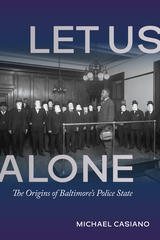 Let Us Alone: The Origins of Baltimore's Police State
Michael Casiano
University of Illinois Press, 2025 By the early twentieth century, postbellum assaults on civil rights and the advent of Jim Crow expanded Baltimore’s law enforcement into a vast network designed to oppress Black people. Michael Casiano’s history charts the institutional consolidation of the city’s post–Civil War police state. Authorities in Baltimore organized and established municipal power in distinct but connected sites that included jails, areas of political and social activism, public schools, street corners, courtrooms, and homes. Casiano analyzes policing in light of two parallel and inextricable realities of the city’s governance. First, policing evolved from an inefficient and vigilante-driven system into a modern and paramilitary endeavor focused on suppressing citizens and maximizing the power, wealth, and reach of capitalists. Second, decades of racial antagonism shaped Baltimore policing into an apparatus primarily oriented around subduing Black freedom. A compelling urban history, Let Us Alone uses voices from all levels of society to examine police power, incarceration, and the perils of being Black in post–Civil War Baltimore.
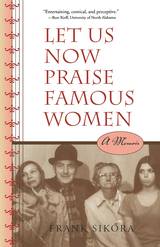 Let Us Now Praise Famous Women: A Memoir
Frank Sikora
University of Alabama Press, 2005 An affectionate, humorous account of small town Alabama during the civil rights era. When Frank Sikora's six-year-old daughter contracted pneumonia in 1962, his wife Millie vowed that would be the last winter she would spend in Ohio. Despite their misgivings about the racial tensions erupting there, they moved their family of six south, where Frank hoped to fulfill his dream of becoming a newspaper reporter. But when those dreams didn't materialize immediately, mounting bills, repossession, and eviction forced them to move in with Millie's parents, Dan and Minnie Belle Helms, in rural Wellington, Alabama. With even slimmer prospects for employment in impoverished Calhoun County, the Sikoras came to depend heavily upon the Helmses and extended family members and all their lives became closely intertwined. The Helmses were uneducated, unpolished people, but Sikora's narration of his life with them—often humorous but never condescending—provides a compelling portrait of the attitudes and lifestyle of poor whites in Alabama during the second half of the 20th century, just as James Agee's monumental work, Let Us Now Praise Famous Men, illuminated the Depression years in Hale County, Alabama. Sikora illustrates how resourceful, southern women, in particular, held their families together through trying times. Interwoven with this commentary on rural white culture in the Deep South is the story of Sikora's developing career as a newsman. Determined to succeed, he finally lands a job with the Gadsden Times reporting the news of black citizens. From that introduction to journalism, Sikora becomes one of Alabama's most acclaimed chroniclers of the civil rights movement, eventually writing some of the acknowledged masterpieces about the subject. Like his landmark book, Selma, Lord, Selma, Sikora's newest work tells the stories of ordinary Alabamians and their perspectives on extraordinary times.
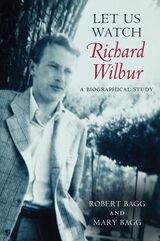 Let Us Watch Richard Wilbur: A Biographical Study
Robert Bagg
University of Massachusetts Press, 2017 Pulitzer Prize–winning poet Richard Wilbur (b. 1921) is part of a notable literary cohort, American poets who came to prominence in the mid-twentieth century. Wilbur's verse is esteemed for its fluency, wit, and optimism; his ingeniously rhymed translations of French drama by Molière, Racine, and Corneille remain the most often staged in the English-speaking world; his essays possess a scope and acumen equal to the era's best criticism. This biography examines the philosophical and visionary depth of his world-renowned poetry and traces achievements spanning seventy years, from political editorials about World War II to war poems written during his service to his theatrical career, including a contentious collaboration with Leonard Bernstein and Lillian Hellman.
Wilbur's life has been mistakenly seen as blessed, lacking the drama of his troubled contemporaries. Let Us Watch Richard Wilbur corrects that view and explores how Wilbur's perceived “normality” both enhanced and limited his achievement. The authors augment the life story with details gleaned from access to his unpublished journals, family archives, candid interviews they conducted with Wilbur and his wife, Charlee, and his correspondence with Robert Lowell, Elizabeth Bishop, John Berryman, John Malcolm Brinnin, James Merrill, and others.
Let Your Hearts and Minds Expand: Reflections on Faith, Reason, Charity, and Beauty
Thomas F. Rogers
Neal A. Maxwell Institute for Religious Scholarship, 2016 Let Your Hearts and Minds Expand is a collection of intelligent, critical, and loving essays spanning forty years of reflection on often overlooked principles of the latter-day gospel by professor, patriarch, and acclaimed playwright Thomas F. Rogers. This collection both exemplifies and encourages a lifetime of devoted scholarship and discipleship.
 Lethal Decisions: The Unnecessary Deaths of Women and Children from HIV/AIDS
Arthur J. Ammann
Vanderbilt University Press, 2017 This first-person account by one of the pioneers of HIV/AIDS research chronicles the interaction among the pediatric HIV/AIDS community, regulatory bodies, governments, and activists over more than three decades. After the discovery of AIDS in a handful of infants in 1981, the next fifteen years showed remarkable scientific progress in prevention and treatment, although blood banks, drug companies, and bureaucrats were often slow to act. 1996 was a watershed year when scientific and clinical HIV experts called for treating all HIV-infected individuals with potent triple combinations of antiretroviral drugs that had been proven effective. Aggressive implementation of prevention and treatment in the United States led to marked declines in the number of HIV-related deaths, fewer new infections and hospital visits, and fewer than one hundred infants born infected each year.
Inexplicably, the World Health Organization recommended withholding treatment for the majority of HIV-infected individuals in poor countries, and clinical researchers embarked on studies to evaluate inferior treatment approaches even while the pandemic continued to claim the lives of millions of women and children. Why did it take an additional twenty years for international health organizations to recommend the treatment and prevention measures that had had such a profound impact on the pandemic in wealthy countries? The surprising answers are likely to be debated by medical historians and ethicists.
At last, in 2015, came a universal call for treating all HIV-infected individuals with triple-combination antiretroviral drugs. But this can only be accomplished if the mistakes of the past are rectified. The book ends with recommendations on how the pediatric HIV/AIDS epidemic can finally be brought to an end.
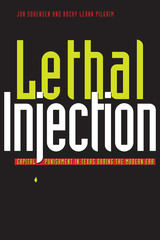 Lethal Injection: Capital Punishment in Texas during the Modern Era
By Jon Sorensen and Rocky LeAnn Pilgrim
University of Texas Press, 2006 Few state issues have attracted as much controversy and national attention as the application of the death penalty in Texas. In the years since the death penalty was reinstated in 1976, Texas has led the nation in passing death sentences and executing prisoners. The vigor with which Texas has implemented capital punishment has, however, raised more than a few questions. Why has Texas been so fervent in pursuing capital punishment? Has an aggressive death penalty produced any benefits? Have dangerous criminals been deterred? Have rights been trampled in the process and, most importantly, have innocents been executed? These important questions form the core of Lethal Injection: Capital Punishment in Texas during the Modern Era. This book is the first comprehensive empirical study of Texas's system of capital punishment in the modern era. Jon Sorensen and Rocky Pilgrim use a wealth of information gathered from formerly confidential prisoner records and a variety of statistical sources to test and challenge traditional preconceptions concerning racial bias, deterrence, guilt, and the application of capital punishment in this state. The results of their balanced analysis may surprise many who have followed the recent debate on this important issue.
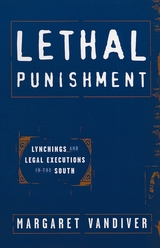 Lethal Punishment: Lynchings and Legal Executions in the South
Vandiver, Margaret
Rutgers University Press, 2005 Why did some offenses in the South end in mob lynchings while similar crimes led to legal executions? Why did still other cases have nonlethal outcomes? In this well-researched and timely book, Margaret Vandiver explores the complex relationship between these two forms of lethal punishment, challenging the assumption that executions consistently grew out of-and replaced-lynchings. Vandiver begins by examining the incidence of these practices in three culturally and geographically distinct southern regions. In rural northwest Tennessee, lynchings outnumbered legal executions by eleven to one and many African Americans were lynched for racial caste offenses rather than for actual crimes. In contrast, in Shelby County, which included the growing city of Memphis, more men were legally executed than lynched. Marion County, Florida, demonstrated a firmly entrenched tradition of lynching for sexual assault that ended in the early 1930s with three legal death sentences in quick succession. With a critical eye to issues of location, circumstance, history, and race, Vandiver considers the ways that legal and extralegal processes imitated, influenced, and differed from each other. A series of case studies demonstrates a parallel between mock trials that were held by lynch mobs and legal trials that were rushed through the courts and followed by quick executions. Tying her research to contemporary debates over the death penalty, Vandiver argues that modern death sentences, like lynchings of the past, continue to be influenced by factors of race and place, and sentencing is comparably erratic.
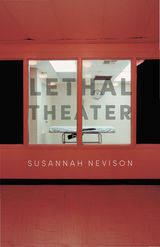 Lethal Theater
Susannah Nevison
Ohio State University Press, 2019 In her new poetry collection, Lethal Theater, Susannah Nevison reckons with the rituals of violence that underpin the American prison system, both domestically and abroad. Exploring the multiple roles of medicine in incarceration, Nevison’s poems expose the psychological and physical pain felt by the prison system’s inhabitants. Nevison asks readers to consider the act and complications of looking—at the spectacle of punishment, isolation, and interrogation, as mapped onto incarcerated bodies—by those who participate in and enforce dangerous prison practices, those who benefit from the exploitation of incarcerated bodies, and those who bear witness to suffering. Unfolding in three sections, Nevison’s poems fluidly move among themes of isolation and violence in prisons during period of war, the history of medical experimentation on domestic prisoners, and the intersection between anesthesia used in hospital settings and anesthesia used in cases of lethal injection. Lethal Theater is an attempt to articulate and make visible a grotesque and overlooked part of American pain.
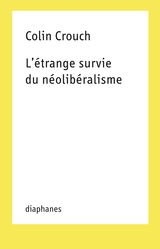 L’étrange survie du néolibéralisme
Colin Crouch
Diaphanes, 2016 Lorsqu'en 2008, la banque d’investissement Lehman Brothers fait faillite, on aurait pu s'attendre à ce que l'ère néolibérale touche à sa fin. Mais c’eût été méconnaître la véritable nature du néolibéralisme, qui ne se résume pas à la suprématie du marché sur l'État. Retraçant les batailles idéologiques et politiques qui opposèrent keynésiens – partisans du levier étatique – et « néolibéraux » – thuriféraires du marché –, Colin Crouch démontre que cette bipolarisation du débat ne permet plus de comprendre les enjeux contemporains du système néolibéral.
L'Étrange Survie du néolibéralisme s'efforce en effet de révéler comment ce combat s'est soldé par l'avènement de très grandes entreprises, un nouveau pouvoir qui fait désormais pièce à l'État comme aux marchés. Loin de s'apparenter à un aride examen des théories néolibérales, ce texte très accessible cherche à penser le rôle de la « société civile », la seule force, selon l'auteur, en mesure de faire face à la triade formée par le marché, l’État et les conglomérats.
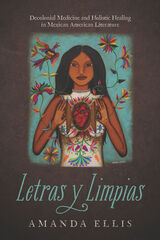 Letras y Limpias: Decolonial Medicine and Holistic Healing in Mexican American Literature
Amanda Ellis
University of Arizona Press, 2021 Letras y Limpias is the first book to explore the literary significance of the figure of the curandera within Mexican American literature. Amanda Ellis traces the significance of the curandera and her evolution across a variety of genres written by leading Mexican American authors, including Américo Paredes, Rudolfo Anaya, Gloria E. Anzaldúa, Manuel Munoz, ire’ne lara silva, and more.
Ellis explores the curandera in relationship to decoloniality, bioethics, and the topic of healing while recognizing the limitations and spiritual shortcomings of Western medicine. Ellis argues that our contemporary western health-care system does not know how to fully grapple with illnesses that patients face. Ellis reads the curandera’s perennial representation as an ongoing example of decolonial love useful for deconstructing narrow definitions of health and personhood, and for grappling with the effects of neoliberalism and colonialism on the health-care industry.
Letras y Limpias draws from Chicana feminist theory to assert the importance of the mindbodyspirit connection. Ellis conveys theoretical insights about the continual reimagining of the figure of the curandera as a watermark across Mexican American literary texts. This literary figure points to the oppressive forces that create susto and reminds us that healing work requires specific attention to colonialism, its legacy, and an intentional choice to carry forward the traditional practices rooted in curanderismo passed on from prior generations. By turning toward the figure of the curandera, readers are better poised to challenge prevailing ideas about health, and imagine ways to confront the ongoing problems that coloniality creates. Letras y Limpias shows how the figure of the curandera offers us ways to heal that have nothing to do with copays or medical professionals refusing care, and everything to do with honoring the beauty and complexity of any, every, and all humans.
Let's All Die Happy
Erin Adair-Hodges
University of Pittsburgh Press, 2017 Winner of the 2016 Agnes Lynch Starrett Poetry Prize
Let’s Be Boldly Bearcat
Kimberlee Dobbs
University of Minnesota Press, 2019 In Let’s Be Boldly Bearcat, the University of Cincinnati bearcat mascot takes young readers on a visual tour of the University of Cincinnati’s campus, pausing at each of the fourteen colleges and regional campuses, to highlight flagship university programs and activities. Readers are invited to answer reflection questions found at the end of the book and to draw pictures to share their ideas about how they would help, teach, build, and keep healthy. A child friendly campus map and a Bearcat coloring activity page complete the book, making this an ideal gift for Cincinnati alumni to share with their young friends and family.
Let's Cook!: The Chang Family Series Board Book
Youmee Lee
Gallaudet University Press, 2025 Grandma is coming to visit! Grandma shows Hwa how to garden and how to make tofu from soybeans with a little bit of magic. Hwa helps Grandma in the garden, and then the whole family eats the yummy dishes that Grandma and Hwa made with love.
Let's Do
Rebecca Meacham
University of North Texas Press, 2004
Let's Explore!: The Chang Family Series Board Book
Youmee Lee
Gallaudet University Press, 2025 Min and his Dad go camping and have an adventure in nature! First, they set up their tent, and then they explore together. They learn how to respect nature by not disturbing things they find. As it gets dark, they use a map to find their way back, and then they build a campfire and look at the stars. They realize that they are part of the wonderful world around them and promise to explore nature again soon.
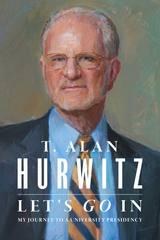 Let’s Go In: My Journey to a University Presidency
T. Alan Hurwitz
Gallaudet University Press, 2020 Alan Hurwitz ascended the ranks of academia to become the president of not one, but two, universities—National Technical Institute for the Deaf at Rochester Institute of Technology and Gallaudet University. In Let’s Go In: My Journey to a University Presidency, Hurwitz discusses the unique challenges he encountered as a Deaf person, and the events, people, and experiences that shaped his personal and professional life. He demonstrates the importance of building a strong foundation for progressive leadership roles in higher education, and provides insights into the decision-making and outreach required of a university president, covering topics such as community collaboration, budget management, and networking with public policy leaders. He also stresses that assessing students’ needs should be a top priority. As he reflects on a life committed to service in higher education, Hurwitz offers up important lessons on the issues, challenges, and opportunities faced by deaf and hard of hearing people, and in doing so, inspires future generations of deaf people to aim for their highest goals.
Additional images, videos, and supplemental readings are available at the Gallaudet University Press/Manifold online platform.
Let's Make!: The Chang Family Series Board Book
Youmee Lee
Gallaudet University Press, 2025 Min asks his parents whether or not he can be an artist. Mom helps him draw and mix colors to paint. Dad shows Min how to preserve memories by taking pictures with his camera. Then Min has a fun idea for the family: let's make an imaginary world! They create together, and Min learns that creating things makes him an artist. When he grows up, he can be anything he wants!
Let's Share!: The Chang Family Series Board Book
Youmee Lee
Gallaudet University Press, 2025 At playtime, Hwa really wants to play with the other children, but she also wants all the fun things for herself! This makes the other children sad because they can't play too. When a friend shares with Hwa, Hwa learns that sharing can be sweet. She starts to share too. Everyone plays together, makes friends, and has fun as they learn signs together.
Let's Sleep!: The Chang Family Series Board Book
Youmee Lee
Gallaudet University Press, 2025 At bedtime, Dad reads Min and Hwa a story about the Moon and the Sun. They wish upon a shooting star, and the stars come to their window! Min becomes the bright Sun, but Hwa is afraid of the dark. After learning about a firefly, she becomes the gentle Moon who shines at night. Just like the Korean folktale the author learned as a child, the Moon and Sun take turns lighting up the world.
Let's Speak Twi: A Proficiency Course in Akan Language and Culture
Adams Bodomo, Charles Marfo, and Lauren Hall-Lew
CSLI, 2010 Let’s Speak Twi is an introductory language-learning textbook for speakers of English and other languages who seek proficiency in Akan Twi, the most widely used and understood native language of Ghana. Included in the book are several practice exercises and activities; an extensive range of culturally relevant topics and dialogues; lists of idiomatic, colloquial, and euphemistic expressions; a reference glossary; and tips on culturally appropriate behavior.
Let's Talk About Critique: Reimagining Art and Design Education
Elissa Armstrong and Mariah Doren
Intellect Books, 2023 Practical and relevant approaches to giving more nuanced critiques.
Let’s Talk about Critique examines how critique in art education has evolved, how it falls short, and what else it could be. Elissa Armstrong and Mariah Doren contextualize current practices by discussing the history of critique, the field of education, and the characteristics of today’s students. Then they offer suggestions for ways to have more open, inclusive, and dynamic classroom conversations about art and design. The core of the book consists of critique format descriptions, written by experienced educators, that provide a wide variety of thoughtful approaches that can be readily adapted and used.
 Let’s Talk About Race in Storytimes
Jessica Anne Bratt
American Library Association, 2021 Foreword by Kirby McCurtis With the help of this book’s adaptable storytime activities, tools for self-reflection, and discussion starters, children’s librarians will learn how to put anti-racism work into their professional practice while fostering an environment that celebrates all identities. As the weekly lists of best-sellers demonstrate, many people want to engage with racial issues. But when it comes to talking about race, they often don’t know how or are hesitant to take the first steps. This includes children's librarians, who are taking seriously our profession’s calls for diversity, equity, and inclusion. They already know that popular storytimes can be an effective way to increase community representation and belonging at the library. Incorporating race into storytimes is an ideal way to foster inclusion by normalizing conversations about these issues. This book will help public and school librarians face their own biases, showing them how to have honest discussions with children, their caregivers, and storytime attendees, as well as their colleagues. In this book, you will discover - several ready-to-use library storytimes that incorporate racial themes, complete with sample activities and booklists;
- an anti-oppression framework, based on the author’s own real-world practice, that is customizable for different settings and situations;
- concrete suggestions for overcoming fears and awkwardness when it comes to talking about race, with advice on practicing new language, making space to connect around appropriate cultural books for read alouds, and evaluating books for storytime;
- interactive self-reflecting worksheets which explore planning picture book introductions and songs for inclusive storytimes, providing age-appropriate glimpses into history, and suggested affirmations in describing skin tone, hair, and language;
- advocacy talking points centered on social justice that will encourage discussion with co-workers and other library staff; and
- guidance on community engagement, relationship building, and intentionally trying to diversify your world in order to truly become an anti-bias practitioner.
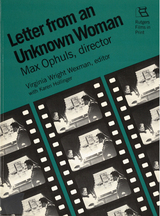 Letter from an Unknown Woman: Max Ophuls, Director
Wexman, Virginia
Rutgers University Press, 1986 The fifth title in the Rutgers Films in Print Series, "Letter from an Unknown Woman" is directed by Max Ophuls and based on the novella by Stefan Zweig. It is the story of Lisa, a young girl who rejects the constricting life of her small town and family in order to dedicate her life to a musician, Stefan. The film's elegant fin-de-siecle Viennese setting, lyrical camera work, dispassionate and ironic point of view, and fine performances by Joan Fontaine and Louis Jourdan elevate what could have been a mere tearjerker into one of Ophuls's finest works. This volume provides a detailed transcription of the 1948 film. Notes appended to the film's continuity script detail all the significant differences between the finished film and the shooting script. Wexman's introductions to each of the book's sections discuss the history of the film's reception and provide an overview of the central issues the film has raised. A cross section of commentary by well-known critics attests to the film's enduring position as a central text for cinema study. These essays acknowledge the film's significance as a preeminent example of Ophuls's art, as an important woman's film, and as a representative of the classic Hollywood style. A biographical sketch of Ophuls, the entire Zweig novella, a bibliography and other background materials are also included.
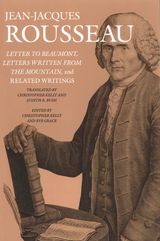 Letter to Beaumont, Letters Written from the Mountain, and Related Writings
Jean-Jacques Rousseau
Dartmouth College Press, 2012 Published between 1762 and 1765, these writings are the last works Rousseau wrote for publication during his lifetime. Responding in each to the censorship and burning of Emile and Social Contract, Rousseau airs his views on censorship, religion, and the relation between theory and practice in politics. The Letter to Beaumont is a response to a Pastoral Letter by Christophe de Beaumont, Archbishop of Paris (also included in this volume), which attacks the religious teaching in Emile. Rousseau’s response concerns the general theme of the relation between reason and revelation and contains his most explicit and boldest discussions of the Christian doctrines of creation, miracles, and original sin. In Letters Written from the Mountain, a response to the political crisis in Rousseau’s homeland of Geneva caused by a dispute over the burning of his works, Rousseau extends his discussion of Christianity and shows how the political principles of the Social Contract can be applied to a concrete constitutional crisis. One of his most important statements on the relation between political philosophy and political practice, it is accompanied by a fragmentary “History of the Government of Geneva.” Finally, “Vision of Peter of the Mountain, Called the Seer” is a humorous response to a resident of Motiers who had been inciting attacks on Rousseau during his exile there. Taking the form of a scriptural account of a vision, it is one of the rare examples of satire from Rousseau’s pen and the only work he published anonymously after his decision in the early 1750s to put his name on all his published works. Within its satirical form, the “Vision” contains Rousseau’s last public reflections on religious issues. Neither the Letter to Beaumont nor the Letters Written from the Mountain has been translated into English since defective translations that appeared shortly after their appearance in French. These are the first translations of both the “History” and the “Vision.”
A Letter to Harvey Milk: Short Stories
Lesléa Newman
University of Wisconsin Press, 2004 This poignant and humorous collection of stories offers a fresh perspective on current issues such as homosexuality and anti-Semitism and lends a unique voice to those experiencing growing pains and self-discovery. Newman’s readers accompany her quirky Jewish characters through all types of experiences from an initial lesbian sexual encounter to being sequestered in a college apartment after paranoid Holocaust flashbacks. In these stories characters anxiously discover their lesbian identities while beginning to understand, and finally to embrace, their Jewish heritage. The title story, "A Letter to Harvey Milk," was the second place finalist in the Raymond Carver Short Story Competition.
Letter to Melania
Evagrius of Pontus
Harvard University Press In a text known as the Letter to Melania, or the Great Letter, Christian monastic philosopher Evagrius of Pontus (345–399) delivers a moving meditation on the power of language (spoken and written), the composition of humanity in light of the three persons of God, and the final restoration or apokatastasis when all creatures will be reunited with their creator. Evagrius wrote in Greek, but after his posthumous condemnation in 551, many of his writings, including this letter, survive only in Syriac translation. The first complete edition of the text, which is based on all known Syriac copies, is presented here alongside a new translation, a Syriac-English glossary, and commentary.
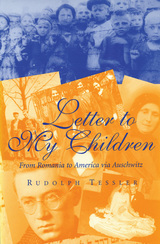 Letter to My Children: From Romania to America via Auschwitz
Rudolph Tessler
University of Missouri Press, 1999 "Sixty-seven members of my family—my mother, her father, my three sisters, three of my brothers, aunts, uncles, and cousins—were murdered at Auschwitz." As Rudolph Tessler's mother stepped from the train in Auschwitz, shortly before she was sent to the gas chamber, she heard "Hello, Esther." In a polite tone, a young German SS officer greeted her as he would any old friend. His family lived down the road from the Tessler family in Viseu, their hometown in northern Romania. They, like the rest of the town, admired Esther for her wonderful cooking, particularly the delicious cakes she brought them each Christmas. Now he ushered her and six of her children to their deaths. Throughout Letter to My Children, Tessler offers vivid glimpses of the senselessness that surrounded him during World War II. Of the thousands packed in trains and transported from Viseu to Auschwitz, just a small group survived to see liberation. Among the survivors were Tessler, his father, and two of his brothers. This is the amazing story of their experiences as Hasidic Jews caught in the chaos and terror of the Holocaust. Tessler's upbringing had emphasized community and family devotion—traits not forgotten in the concentration camps, where he and his family members often rescued one another from certain death. Few fathers and sons survived the concentration camps together. In spite of the odds, Tessler and his brother Buroch managed to stick together, sharing their father's labor assignments to protect him from death, preserving not only their family bond but also their spirituality. Tessler's father, always a source of strength and guidance to his family, provided counsel to many prisoners in the camp and eventually assumed the role of rabbi. Despite an environment in which their captors tried to reduce them to animals, Tessler's remaining family and seven other Jews from Viseu made a special effort to observe their faith. Bending rules in ways that risked their lives, they worked together to smuggle wheat, grind it into flour, and bake matzos to distribute for Passover. The group also secretly gathered to pray on the eve of Rosh Hashanah. These religious observances offered some comfort in the camp. In addition to vividly portraying the daily struggles of camp life, Letter to My Children follows Tessler beyond liberation, recounting his days as a displaced person struggling for a new life in the midst of the devastation of postwar Europe, as an American immigrant striving to rebuild his family and succeed in business, and as a philanthropist for education and health care. Recalling the age-old way of life in Viseu that was erased by the Holocaust, this inspiring story conveys the hope, determination, and perseverance that made Tessler a survivor.
Letter to the World: Seven Women Who Shaped the American Century
Susan Ware
Harvard University Press Susan Ware deftly chronicles the professional and private lives of seven notable women of our century. She shows how the creation or re-creation of their personae was an essential element in their success, whether they craved fame or chose a different lifestyle. She pays special attention to how they balanced their lives--married, single, or with partners, with or without children--to provide examples for today's women. All seven women chose to live exceptional and unconventional lives, offering other women examples of the ability to live beyond the limits imposed by society or family, to dream and strive, to be independent and fulfilled.
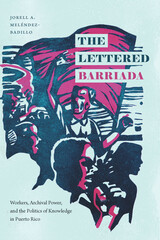 The Lettered Barriada: Workers, Archival Power, and the Politics of Knowledge in Puerto Rico
Jorell A. Meléndez-Badillo
Duke University Press, 2021 In The Lettered Barriada, Jorell A. Meléndez-Badillo tells the story of how a cluster of self-educated workers burst into Puerto Rico's world of letters and navigated the colonial polity that emerged out of the 1898 US occupation. They did so by asserting themselves as citizens, producers of their own historical narratives, and learned minds. Disregarded by most of Puerto Rico's intellectual elite, these workers engaged in dialogue with international peers and imagined themselves as part of a global community. They also entered the world of politics through the creation of the Socialist Party, which became an electoral force in the first half of the twentieth century. Meléndez-Badillo shows how these workers produced, negotiated, and deployed powerful discourses that eventually shaped Puerto Rico's national mythology. By following these ragtag intellectuals as they became politicians and statesmen, Meléndez-Badillo also demonstrates how they engaged in racial and gender silencing, epistemic violence, and historical erasures in the fringes of society. Ultimately, The Lettered Barriada is about the politics of knowledge production and the tensions between working-class intellectuals and the state.
Duke University Press Scholars of Color First Book Award recipient
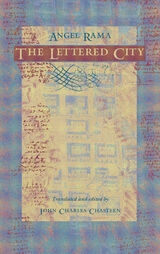 The Lettered City
Angel Rama
Duke University Press, 1996 Posthumously published to wide acclaim, The Lettered City is a vitally important work by one of Latin America’s most highly respected theorists. Angel Rama’s groundbreaking study—presented here in its first English translation—provides an overview of the power of written discourse in the historical formation of Latin American societies, and highlights the central role of cities in deploying and reproducing that power. To impose order on a vast New World empire, the Iberian monarchs created carefully planned cities where institutional and legal powers were administered through a specialized cadre of elite men called letrados; it is the urban nexus of lettered culture and state power that Rama calls “the lettered city.”
Starting with the colonial period, Rama undertakes a historical analysis of the hegemonic influences of the written word. He explores the place of writing and urbanization in the imperial designs of the Iberian colonialists and views the city both as a rational order of signs representative of Enlightenment progress and as the site where the Old World is transformed—according to detailed written instructions—in the New. His analysis continues by recounting the social and political challenges faced by the letrados as their roles in society widened to include those of journalist, fiction writer, essayist, and political leader, and how those roles changed through the independence movements of the nineteenth century. The coming of the twentieth century, and especially the gradual emergence of a mass reading public, brought further challenges. Through a discussion of the currents and countercurrents in turn-of-the-century literary life, Rama shows how the city of letters was finally “revolutionized.”
Already crucial in setting the terms for debate concerning the complex relationships among intellectuals, national formations, and the state, this elegantly written and translated work will be read by Latin American scholars in a wide range of disciplines, and by students and scholars in the fields of anthropology, cultural geography, and postcolonial studies.
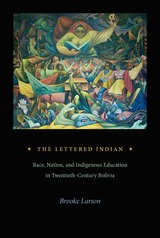 The Lettered Indian: Race, Nation, and Indigenous Education in Twentieth-Century Bolivia
Brooke Larson
Duke University Press, 2024 Bringing into dialogue the fields of social history, Andean ethnography, and postcolonial theory, The Lettered Indian maps the moral dilemmas and political stakes involved in the protracted struggle over Indian literacy and schooling in the Bolivian Andes. Brooke Larson traces Bolivia’s major state efforts to educate its unruly Indigenous masses at key junctures in the twentieth century. While much scholarship has focused on “the Indian boarding school” and other Western schemes of racial assimilation, Larson interweaves state-centered and imperial episodes of Indigenous education reform with vivid ethnographies of Aymara peasant protagonists and their extraordinary pro-school initiatives. Exploring the field of vernacular literacy practices and peasant political activism, she examines the transformation of the rural “alphabet school” from an instrument of the civilizing state into a tool of Aymara cultural power, collective representation, and rebel activism. From the metaphorical threshold of the rural school, Larson rethinks the politics of race and indigeneity, nation and empire, in postcolonial Bolivia and beyond.
 The Lettered Knight: Knowledge and aristocratic behaviour in the twelfth and thirteenth centuries
Martin Aurell
Central European University Press, 2017 The encounter between knight and science could seem a paradox. It is nonetheless related with the intellectual Renaissance of Twelfth-Century, an essential movement for Western history. The knight is not only fighting in battles, but also moving in sophisticated courts. He is interested on Latin classics and reading, and even on his own poetry. He supports "jongleurs" and minstrels and he likes to have literary conversations with clerics, who try to reform his behaviour, which is often brutal. These lettered warriors, while improving they culture, learn how to repress their own violence and they are initiated to courtesy: selected language, measured gestures, elegance in dress, and manners at table. Their association with women, who are often learned, becomes more gallant. A mental revolution is acting among lay elites, who, in contact with clergy, use their weapons for common welfare. This new conduct is a sign of modernity.
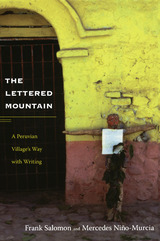 The Lettered Mountain: A Peruvian Village’s Way with Writing
Frank Salomon and Mercedes Niño-Murcia
Duke University Press, 2011 Andean peoples joined the world of alphabetic literacy nearly 500 years ago, yet the history of their literacy has remained hidden until now. In The Lettered Mountain, Frank Salomon and Mercedes Niño-Murcia expand notions of literacy and challenge stereotypes of Andean “orality” by analyzing the writings of mountain villagers from Inka times to the Internet era. Their historical ethnography is based on extensive research in the village of Tupicocha, in the central Peruvian province of Huarochirí. The region has a special place in the history of Latin American letters as the home of the unique early-seventeenth-century Quechua-language book explaining Peru’s ancient gods and priesthoods. Granted access to Tupicocha’s surprisingly rich internal archives, Salomon and Niño-Murcia found that legacy reflected in a distinctive version of lettered life developed prior to the arrival of state schools. In their detailed ethnography, writing emerges as a vital practice underlying specifically Andean sacred culture and self-governance. At the same time, the authors find that Andean relations with the nation-state have been disadvantaged by state writing standards developed in dialogue with European academies but not with the rural literate tradition.
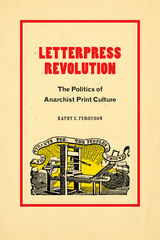 Letterpress Revolution: The Politics of Anarchist Print Culture
Kathy E. Ferguson
Duke University Press, 2023 While the stock image of the anarchist as a masked bomber or brick thrower prevails in the public eye, a more representative figure should be a printer at a printing press. In Letterpress Revolution, Kathy E. Ferguson explores the importance of printers, whose materials galvanized anarchist movements across the United States and Great Britain from the late nineteenth century to the 1940s. Ferguson shows how printers—whether working at presses in homes, offices, or community centers—arranged text, ink, images, graphic markers, and blank space within the architecture of the page. Printers' extensive correspondence with fellow anarchists and the radical ideas they published created dynamic and entangled networks that brought the decentralized anarchist movements together. Printers and presses did more than report on the movement; they were constitutive of it, and their vitality in anarchist communities helps explain anarchism’s remarkable persistence in the face of continuous harassment, arrest, assault, deportation, and exile. By inquiring into the political, material, and aesthetic practices of anarchist print culture, Ferguson points to possible methods for cultivating contemporary political resistance.
Letters
Saint Leo the Great
Catholic University of America Press, 1957 No description available
Letters
Angelo PolizianoEdited and translated by Shane Butler
Harvard University Press, 2006 Angelo Poliziano (1454-1494) was one of the great scholar-poets of the Italian Renaissance and the leading literary figure of the Age of Lorenzo de' Medici, "il Magnifico." His correspondence gives us an intimate glimpse of the revival of classical literature from the pen of a man at the very center of the Renaissance movement. This volume illuminates his close friendship with the philosopher Pico della Mirandola and includes much of the correspondence concerning the composition and reception of his Miscellanies, a revolutionary work of philology. It also includes his famous and moving letter on the death of Lorenzo de' Medici. This volume contains the first modern edition of the Latin text and the first translation of the letters into English.
Letters
David Garrick
Harvard University Press
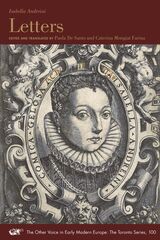 Letters
Isabella Andreini
Iter Press, 2023 A collection of inventive writings in letter form from a sixteenth-century star of commedia dell'arte.
Isabella Andreini (1562–1604) was a commedia dell’arte diva who toured Italy and France as part of the Compagnia dei Comici Gelosi. Letters is a collection of epistles written by Andreini in fictional, anonymous, male, and female voices, a “hermaphroditic” alternation of gender unlike any that had been seen in letter writing to that time. In her letters, Andreini remade the humanistic epistolary genre into a distinctive fusion of literary and dramatic performance. The guise of epistolary intimacy cedes to a knowing artificiality, which allows for the emergence of Andreini’s modern critique of the gendered self as a uniform entity. The collection centers on love and examines—from surprising perspectives—pertinent issues such as death, the birth of a girl, prostitution, patriarchal marital practices, love in old age, courtiership, country and city life, human nature, and defenses and critiques of both sexes.
Letters
David Garrick
Harvard University Press
Letters
David Garrick
Harvard University Press
Letters
David Garrick
Harvard University Press
Letters, 121-150
Peter Damian
Catholic University of America Press, 2004 No description available
Letters, 1-30
Peter Damian
Catholic University of America Press, 1989 Peter Damian (1007-1072), an eleventh-century monk and man of letters, left a large and significant body of correspondence. Over one hundred and eighty letters have been preserved, principally from Damian's own monastery of Fonte Avellana. Ranging in length from short memoranda to longer monographs, the letters provide a contemporary account of many of the controversies of the eleventh century: purgatory, the Eucharist, clerical marriage and celibacy, immorality, and others. Peter Damian, or "Peter the Sinner" as he often referred to himself, was one of the most learned men of his day, and his letters are filled with both erudition and zeal for reform.
Letters 1–50
Saint Cyril of Alexandria
Catholic University of America Press, 1987 No description available
Letters, 151-180
Peter Damian
Catholic University of America Press, 2005 No description available
Letters (1–81)
Saint Cyprian
Catholic University of America Press, 1964 The letters, of which eighty-one have come down to us, written from c.249 until his death in 258 A.D., may be found translated in this volume.
Letters, 1-91
Saint Ambrose
Catholic University of America Press, 1954 The Letters 1-91 of Saint Ambrose.
Letters, 31-60
Peter Damian
Catholic University of America Press, 1990 Peter Damian (1007-1072), an eleventh-century monk and man of letters, left a large and significant body of correspondence. Over one hundred and eighty letters have been preserved, principally from Damian's own monastery of Fonte Avellana. Ranging in length from short memoranda to longer monographs, the letters provide a contemporary account of many of the controversies of the eleventh century: purgatory, the Eucharist, clerical marriage and celibacy, immorality, and others. Peter Damian, or "Peter the Sinner" as he often referred to himself, was one of the most learned men of his day, and his letters are filled with both erudition and zeal for reform.
Letters 51–110
Saint Cyril of Alexandria
Catholic University of America Press, 1987 No description available
Letters, 61-90
Peter Damian
Catholic University of America Press, 1992 Peter Damian (1007-1072), an eleventh-century monk and man of letters, left a large and significant body of correspondence. Over one hundred and eighty letters have been preserved, principally from Damian's own monastery of Fonte Avellana. Ranging in length from short memoranda to longer monographs, the letters provide a contemporary account of many of the controversies of the eleventh century: purgatory, the Eucharist, clerical marriage and celibacy, immorality, and others. Peter Damian, or "Peter the Sinner" as he often referred to himself, was one of the most learned men of his day, and his letters are filled with both erudition and zeal for reform.
Letters 91-120
Peter Damian
Catholic University of America Press, 1998 No description available
The Letters and Journals
Paula Modersohn-Becker
Northwestern University Press, 1998 One of the great modern painters, Paula Modersohn-Becker was also a gifted writer who left behind journals and a sizable correspondence. This edition includes every extant letter, all carefully annotated, and is illustrated with forty-six black-and-white plates.
 Letters and Journals of James Fenimore Cooper
James Fenimore Cooper
Harvard University Press James Fenimore Cooper's magnificent vision of American civilization was probably doomed from the outset. Yet the dream died hard, as the years (1845-1851) recorded in volumes V and VI of his Letters and Journals show. Vigorous and perceptive as ever at 55, he continued to combat forces in the national life that he feared were destroying its civility and constitutional structures. When, finally, he realized that his efforts were barren, he found some solace in religion. Cooper mellowed perceptibly in his later years, and his genius for friendship is perhaps better revealed here than in earlier volumes. And his range of observation remained kaleidoscopic: the Mexican War, the Navy, the French Revolution of 1848, the theatre, and the latest New York scandal. Nor did his productivity slacken. Between 1845 and 1850, he averaged two books a year, undertook a revised edition of his works in fine format, composed a play, and, at the time of his death, had in press The Towns of Manhattan, which was to have been the first history of Greater New York City. Volume VI provides a cumulative index to the entire edition and contains an important section of additional letters (1825-1844) discovered since the earlier volumes were published.
 Letters and Journals of James Fenimore Cooper
James Fenimore Cooper
Harvard University Press James Fenimore Cooper's magnificent vision of American civilization was probably doomed from the outset. Yet the dream died hard, as the years (1845-1851) recorded in volumes V and VI of his Letters and Journals show. Vigorous and perceptive as ever at 55, he continued to combat forces in the national life that he feared were destroying its civility and constitutional structures. When, finally, he realized that his efforts were barren, he found some solace in religion. Cooper mellowed perceptibly in his later years, and his genius for friendship is perhaps better revealed here than in earlier volumes. And his range of observation remained kaleidoscopic: the Mexican War, the Navy, the French Revolution of 1848, the theatre, and the latest New York scandal. Nor did his productivity slacken. Between 1845 and 1850, he averaged two books a year, undertook a revised edition of his works in fine format, composed a play, and, at the time of his death, had in press The Towns of Manhattan, which was to have been the first history of Greater New York City.
 Letters and Journals of James Fenimore Cooper
James Fenimore Cooper
Harvard University Press James Fenimore Cooper's magnificent vision of American civilization was probably doomed from the outset. Yet the dream died hard, as the years (1845-1851) recorded in volumes V and VI of his Letters and Journals show. Vigorous and perceptive as ever at 55, he continued to combat forces in the national life that he feared were destroying its civility and constitutional structures. When, finally, he realized that his efforts were barren, he found some solace in religion. Cooper mellowed perceptibly in his later years, and his genius for friendship is perhaps better revealed here than in earlier volumes. And his range of observation remained kaleidoscopic: the Mexican War, the Navy, the French Revolution of 1848, the theatre, and the latest New York scandal. Nor did his productivity slacken. Between 1845 and 1850, he averaged two books a year, undertook a revised edition of his works in fine format, composed a play, and, at the time of his death, had in press The Towns of Manhattan, which was to have been the first history of Greater New York City. Volume VI provides a cumulative index to the entire edition and contains an important section of additional letters (1825-1844) discovered since the earlier volumes were published.
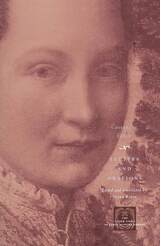 Letters and Orations
Cassandra Fedele
University of Chicago Press, 2000 By the end of the fifteenth century, Cassandra Fedele (1465-1558), a learned middle-class woman of Venice, was arguably the most famous woman writer and scholar in Europe. A cultural icon in her own time, she regularly corresponded with the king of France, lords of Milan and Naples, the Borgia pope Alexander VI, and even maintained a ten-year epistolary exchange with Queen Isabella and King Ferdinand of Spain that resulted in an invitation for her to join their court. Fedele's letters reveal the central, mediating role she occupied in a community of scholars otherwise inaccessible to women. Her unique admittance into this community is also highlighted by her presence as the first independent woman writer in Italy to speak publicly and, more importantly, the first to address philosophical, political, and moral issues in her own voice. Her three public orations and almost all of her letters, translated into English, are presented here for the first time.
Letters and Poems to and from Her Mentor and Other Members of Her Circle
Anna Maria van Schurman
Iter Press, 2021 Anna Maria van Schurman was widely regarded as the most erudite woman in seventeenth-century Europe. As “the Star of Utrecht,” she was active in a network of learning that included the most renowned scholars of her time. Known for her extensive learning and her defense of the education of women, she was the first woman to sit in on lectures at a university in the Netherlands and to advocate that women be admitted into universities. She was proficient in fourteen languages, including Latin, Greek, Hebrew, Arabic, Syriac, Aramaic, Persian, Samaritan, and Ethiopian, as well as several vernacular European languages.
This volume presents in translation a remarkable collection of her letters and poems—many of which were previously unpublished—that span almost four decades of her life, from 1631 to 1669.
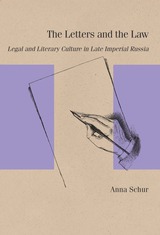 The Letters and the Law: Legal and Literary Culture in Late Imperial Russia
Anna Schur
Northwestern University Press, 2022 The Letters and the Law explores the fraught relationship between writers and lawyers in the four decades following Alexander II’s judicial reforms. Nineteenth-century Russian literature abounds in negative images of lawyers and the law. Literary scholars have typically interpreted these representations either as the common, cross‑cultural critique of lawyerly unscrupulousness and greed or as an expression of Russian hostility toward Western legalism, seen as antithetical to traditional Russian values. The Letters and the Law is the first book to frame the conflict in terms of the two professions’ competition for cultural authority.
Anna Schur combines historical research and literary analysis to argue that the first generations of Russian trial lawyers shaped their professional identity with an eye to the celebrated figure of the writer and that they considered their own activities to be a form of verbal art. A fuller understanding of writers’ antipathy to the law, Schur contends, must take into account this overlooked cultural backdrop. Laced with the better‑known critique of the lawyer’s legalistic proclivities and lack of moral principle are the writer’s reactions to a whole network of explicit and implicit claims of similarity between the two professions’ goals, methods, and missions that were central to the lawyer’s professional ideal. Viewed in this light, writers’ critiques of the law and lawyers emerge as a concerted effort at protecting literature’s exclusive cultural status in the context of modernization and the rapidly expanding public sphere.
The study draws upon a mix of well-known and rarely studied nineteenth-century authors and texts—with particular attention paid to Fyodor Dostoevsky and Mikhail Saltykov-Shchedrin—and on a wide range of nonliterary sources, including courtroom speeches, guides to forensic oratory, legal treatises, and specialized press.
 Letters around a Garden
Rainer Maria Rilke
Seagull Books, 2024 An intimate glimpse into the life and letters of Rainer Maria Rilke, one of the most important poets of the twentieth century.
In July 1921, displaced European poet Rainer Maria Rilke sequestered himself in the chateau of Muzot, a thirteenth-century medieval tower perched in the vineyards above the town of Sierre in the Canton Valais, Switzerland. In this sun-flooded landscape of the Rhone Valley, he found beguiling echoes of Spain and his beloved Provence. Here, the Duino Elegies were famously completed and the Sonnets to Orpheus followed.
During this time, Rilke’s correspondence also bloomed, and Letters around a Garden collects some of those letters together into English for the first time. One intriguing exchange from 1924 to 1926 was with a young aristocratic Swiss woman Antoinette de Bonstetten, a passionate horticulturist who had been recommended as a potential advisor for the redesign and upkeep of the Muzot rose garden. In twenty-two precious letters originally written in French, Rilke relishes the prospect of their elusive meeting, keenly discusses the plans for his garden, and wittily laments the trials of his plants. Beyond the encomium for Paul Valéry and poignant memory of place are passages of exquisite writing, in which Rilke evokes with trademark sensitivity the delicate relationship between the changing seasons and the natural world of his adopted region. We also witness the loving relationship evolve between these sometime-fugitive correspondents and how questions of solitariness and companionship impinge on one who faces unaccustomed challenges as his health tragically declines.
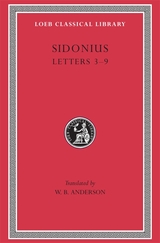 Letters: Books 3–9
Sidonius
Harvard University Press Belles lettres.
Sidonius Apollinaris, a Gallo-Roman, was born at Lugdunum (Lyon) about AD 430. He married Papianilla, daughter of the Emperor Avitus in whose honor he recited at Rome on 1 January 456 a panegyric in verse. Sidonius later joined a rebellion, it seems, but was finally reconciled to the emperor Majorian and delivered at Lyon in 458 a panegyric on him. After some years in his native land, in 467 he led a Gallo-Roman deputation to the Emperor Anthemius, and on 1 January 468 recited at Rome his third panegyric. He returned to Gaul in 469 and became Bishop of Auvergne with seat at Clermont-Ferrand. He upheld his people in resisting the Visigoths. After Auvergne was ceded to them in 475, he was imprisoned but soon resumed his bishopric. He was canonized after his death.
The Loeb Classical Library edition of Sidonius is in two volumes. The first contains his poetry: the three long panegyrics, and poems addressed to or concerned with friends, apparently written in his youth. Volume I also contains Books 1–2 of his Letters (all dating from before his episcopate); Books 3–9 are in Volume II. Sidonius’ writings shed valued light on Roman culture in the fifth century.
Letters Familiar and Formal
Arcangela Tarabotti
Iter Press, 2012 Coerced into taking the veil, Venetian writer Arcangela Tarabotti (1604–1652) spent her life protesting the practice of forcing girls into convents. Her fearless defense of women and attacks on patriarchal Venetian society earned her renown and access to the presses. Her publications, however, invited constant controversy. Tarabotti published her Letters Familiar and Formal to protect and enhance her literary reputation while also chronicling contemporary literary society and material existence in an early modern convent. The Letters flaunted Tarabotti’s literary accomplishments, humiliated her critics, and advertised her powerful network of allies in Northern Italy and France. The Letters document how Tarabotti established herself as one of the most forceful proponents for women’s self-determination in early modern Europe.
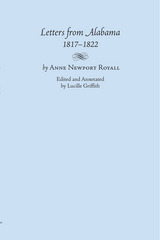 Letters from Alabama, 1817–1822
Anne Newport Royall
University of Alabama Press, 1969 Letters of an outspoken “first” woman journalist in Alabama
Anne Royall was a prominent woman journalist for more than a quarter of a century before her death in 1854, publishing some ten books of travel accounts, one novel, and two successive weekly newspapers in Washington, and sponsoring causes, often unpopular, in the manner of latter-day "muckrakers." She was a well-known habitue of the halls of Congress, looking for news and subscribers, sniffing out irregularities in governmental departments, and pressing claims for a pension which she believed should have been hers from her Revolutionary War husband. For those who helped her she had high, often inordinate, praise; for those who refused her or crossed her path she was a "holy terror," lashing out against them often in intemperate language. Through the columns of her paper she debated such public issues as the Bank, antiMasonry, Nullification, and the franking privilege; she was forever attacking what she considered a very diabolical plot to unite church and state. There was never a doubt where she stood on any of the issues on which she spoke out; she was no compromiser or "fence-straddler." She has the distinction of being the only woman in our national history who was tried (and convicted) for being a "common scold." She was, in short, an aggressive, intolerant, outspoken, suspicious, meddlesome, nonconforming but patriotic, and fascinating woman.
Anne Royall, we might say, began her journalistic career in Alabama. Although the letters were not published until 1830, some four years after Sketches of History, Life and Manners in the United States, they were her :first literary effort. Ostensibly written to a young lawyer friend “Matt” in Virginia, the letters are dated from November 28, 1817 to June 8, 1822.. The letters include, in addition to personal matters and comments on the inconveniences of travel, a considerable amount of description of the country through which she traveled and discussions -often lengthy-of religion, literature, education, social injustices, crops, and important personages she met in her travels. While she is often outspoken, her comments in these letters are more temperate than those in her later works.
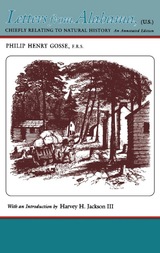 Letters from Alabama: Chiefly Relating to Natural HIstory
Philip Henry Gosse, introduction by Harvey H Jackson, edited by Virginia Hamilton
University of Alabama Press, 1993 Philip Henry Gosse (1810-1888), a British naturalist, left home at age 17 and made his way to Alabama in 1838, where he had heard educated people were in demand. He was employed by Judge Reuben Saffold at Pleasant Hill in Dallas County as a teacher for about a dozen children of local landowners, but his principal interest was natural history. During the eight months he lived in th Black Belt he watched, listened, thought, took notes, and made sketches--activities that eventually led to Letters from Alabama. He lived among Alabamians, talked and listened to them, saw them at their best and their worst, and came to understand their hopes and fears. They were a part of the natural world, and he paid attention to them as any good scientist would. With the skills of a scientist and the temperament of an artist, Gosse set down an account of natural life in frontier Alabama that has no equal. Written to no one in particular, a common literary device of the period, the letters were first published in a magazine, and in 1859 appeared as a book. By that time Gosse was an established scholar and one of England’s most noted scientific illustrators.
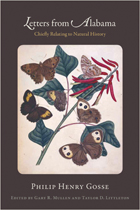 Letters from Alabama: Chiefly Relating to Natural History
Philip Henry Gosse, Edited by Gary R. Mullen and Taylor D. Littleton
University of Alabama Press, 2013 This new and improved edition of Letters from Alabama offers a valuable window into pioneer Alabama and the landscape and life-forms encountered by early settlers of the state. Philip Henry Gosse (1810–1888), a British naturalist, left home at age seventeen and made his way to Alabama in 1838. He was employed by Judge Reuben Saffold and other planters near Pleasant Hill in Dallas County as a teacher for about a dozen of their children, but his principal interest was natural history. Letters from Alabama is a personalized record of Gosse’s perceptive observations during his eight-month residence in this small antebellum community. The work addresses a Victorian readership, including entomologists, who Gosse believed were relatively uninformed about the novelty and beauty of this “hilly region of the State of Alabama.” Written in an engaging literary style and organized as a series of epistolary discussions, the book is unparalleled in its detailed evocations of the natural history and cultural conditions of frontier Alabama. By the time Letters from Alabama appeared in 1859, Gosse’s scientific publications and fine illustrations had led to his being elected a Fellow of the Royal Society of London. Edited by Gary R. Mullen and Taylor D. Littleton, this authoritative edition features thirty grayscale lithographs shot directly from the 1859 edition, reset type for easier reading, a new introduction and index by the two foremost scholars of Gosse in Alabama, a new appendix that provides modern scientific and common names for the plant and animal species described by Gosse, and a four-color cover featuring one of the plates from Gosse’s Entomologia Alabamensis.
Letters From Alaska
John Muir
University of Alaska Press, 2009 John Muir (1838–1914), founder of the Sierra Club, was one of the most famous and influential environmental conservationists of all time. From 1879 to 1880 Muir traveled the waters of southeastern Alaska in a Tlingit Indian dugout canoe and reported his encounters in a series of letters published in the San Francisco Daily Evening Bulletin. Collected here are Muir’s original letters, bearing the immediacy and candor of his best work and providing a rare account of southeastern Alaska history, alongside breathtaking observations of glaciers and the untamed landscape. Through Muir we encounter gold miners, rogue towns, Taku Inlet, Glacier Bay, profiles of Tlingit Indians, and the infancy of the tourist industry. This collection of work by one of America’s foremost naturalists provides a magnificent look into early conservationist thought and one individual’s encounter with nature.
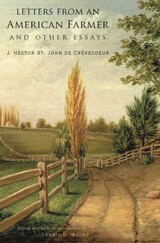 Letters from an American Farmer and Other Essays
J. Hector St. John de Crèvecoeur
Harvard University Press, 2013 Letters from an American Farmer was published in London in 1782, just as the idea of an “American” was becoming a reality. Those epistolary essays introduced the European public to America’s landscape and customs and have since served as the iconic description of a then-new people. Dennis D. Moore’s convenient, up-to-date reader’s edition situates those twelve pieces from the 1782 Letters in the context of thirteen other essays representative of Crèvecoeur’s writings in English.
The “American Farmer” of the title is Crèvecoeur’s fictional persona Farmer James, a bumpkin from rural Pennsylvania. In his Introduction to this edition, Moore places this self-effacing pose in perspective and charts Crèvecoeur’s enterprising approach to self-promotion, which involved repackaging and adapting his writings for French and English audiences.
Born in Normandy, Crèvecoeur came to New York in the 1750s by way of England and then Canada, traveled throughout the colonies as a surveyor and trader, and was naturalized in 1765. The pieces he included in the 1782 Letters map a shift from hopefulness to disillusionment: its opening selections offer America as a utopian haven from European restrictions on personal liberty and material advancement but give way to portrayals of a land plagued by the horrors of slavery, the threat of Indian raids, and revolutionary unrest. This new edition opens up a broader perspective on this artful, ambitious writer and cosmopolitan thinker who coined America’s most enduring metaphor: a place where “individuals of all nations are melted into a new race of men.”
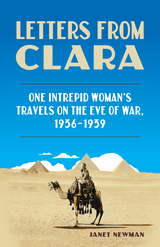 Letters from Clara: One Intrepid Woman's Travels on the Eve of War, 1936-1939
Janet Newman
Wisconsin Historical Society Press, 2022 A unique collection of letters from a member of the YWCA on her first world tour in the 1930s, Letters from Clara tells one woman’s story of adventure and danger on the eve of World War II. Despite limited financial means, Clara Pagel was richly resourceful and used the YWCA network to find work and places to live in the Far East, along the way meeting other women also working their way around the world. As Clara described in letters to her YWCA friends back home, her sojourn was filled with museums and world-famous landmarks, as well as typhoons, bombings, and earthquakes. These experiences are described in over one hundred pages of letters, annotated throughout by Janet Newman. Upon Clara’s return to the United States in 1939, she enrolled at the University of Chicago and earned an MBA at the age of forty-six. This is the story of a remarkable woman on an unexpected but fulfilling journey to learn about the world and herself.
Letters from Limbo
Jeanne Marie Beaumont
CavanKerry Press, 2016 In Letters from Limbo, voices of the dead reach the living through various means, including the titular letters, revealing experiences harrowing and mysterious, and exploring limbo as an abode of souls as well as a state of entrapment and intermediacy. Fluent in many modes—lyric to documentary—the poet commands varied poetic forms. That we dwell in metaphorical limbos by virtue of our unpredictable earthly sojourn is a haunting truth this book both illuminates and celebrates.
Letters from Lockdown: Sustaining Public Service Values During the Covid-19 Pandemic
Claire Foster-Gilbert
Haus Publishing, 2020 During the first months of the coronavirus lockdown, Claire Foster-Gilbert, director of Westminster Abbey Institute, wrote twelve weekly letters to Britain’s public servants. Intended to strengthen their response to the rapidly changing needs of an increasingly unfamiliar world, these letters chart a heroic journey through initial uncertainty and crushing trials toward unprecedented unity and transformed resolve. Rather than bunker down, she asks us to consider: what might we discover, imagine, and change for the better as a result of the pandemic?
Letters from the Lockdown presents the twelve original letters alongside new, deeply personal accounts from public servants on the job. Together, this collection provides an opportunity to reflect on how public values meet practice as the global crisis unfolds.
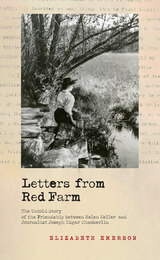 Letters from Red Farm: The Untold Story of the Friendship between Helen Keller and Journalist Joseph Edgar Chamberlin
Elizabeth Emerson
University of Massachusetts Press, 2021 In 1888, young Helen Keller traveled to Boston with her teacher, Annie Sullivan, where they met a man who would change her life: Boston Transcript columnist and editor Joseph Edgar Chamberlin. Throughout her childhood and young adult years, Keller spent weekends and holidays at Red Farm, the Chamberlins' home in Wrentham, Massachusetts, a bustling environment where avant-garde writers, intellectuals, and social reformers of the day congregated. Keller eventually called Red Farm home for a year when she was sixteen.
Informed by previously unpublished letters and extensive research, Letters from Red Farm explores for the first time Keller's deep and enduring friendship with the man who became her literary mentor and friend for over forty years. Written by Chamberlin's great-great granddaughter, this engaging story imparts new insights into Keller's life and personality, introduces the irresistible Chamberlin to a modern public, and follows Keller's burgeoning interest in social activism, as she took up the causes of disability rights, women's issues, and pacifism.
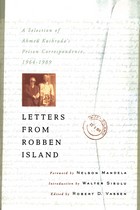 Letters from Robben Island: A Selection of Ahmed Kathrada's Prison Correspondence, 1964-1989
Robert D. Vassen
Michigan State University Press, 1999 Late one night in July, 1963, a South African police unit surrounded the African National Congress headquarters in Rivonia and arrested a group of Movement leaders gathered inside. Eventually eight of them, including Nelson Mandela, who was already serving a sentence, Walter Sisulu, Dennis Goldberg, Govan Mbeki, Raymond Mhlaba, Elias Motsoledi, Andrew Mangeni, and Ahmed Kathrada, were convicted of sabotage and, on June 12, 1964, sentenced to life in prison. Soon, these men became widely known as the "Rivonia Trialists." Despite their imprisonment, the Trialists played active roles in the struggle against South Africa's racist regime. Instead of being forgotten, as apartheid officials had hoped, they became enduring symbols in a struggle against injustice and racism.
Kathrada and his colleagues were classified as high security prisoners, segregated from others and closely watched. Every activity was regulated and monitored. Among the many indignities visited upon them, the prisoners were prohibited from keeping copies of incoming and outgoing correspondence. Kathrada, or "Kathy" as he is known, successfully hid both.
Letters From Robben Island contains a selection of 86 of the more than 900 pieces of correspondence Ahmed Kathrada wrote during his 26 years on Robben Island and at Pollsmoor Prison. Some were smuggled out by friends; others were written in code to hide meaning and content from prison censors. These are among his most poignant, touching, and eloquent communications. They are testimonies to Kathrada, his colleagues, and to their commitment to obtaining human dignity and freedom for all South Africans.
 Letters from Sardis
George M. A. Hanfmann
Harvard University Press, 1972 The metropolis of Asia Minor and one of the great capitals of antiquity, Sardis was the place where legendary Croesus ruled, where coinage was invented, and economic history revolutionized. The letters published in this book provide an informal account of fourteen years of work by a Harvard-Cornell team to retrieve evidence of the greatness of Lydian culture as well as of the Prehistoric, Hellenistic, Roman, and Byzantine civilizations that preceded and followed the Lydian kingdom.
Written each season from the field by George Hanfmann, Field Director of the expedition and John E. Hudson Professor of Archaeology at Harvard University, the letters have allowed friends and supporters of the project to share in the important aspects of a dig at a major site—the excitement and disappointments inherent in a scholarly quest of long-buried cultures, the multiplicity of unexpected complications, human, mechanical, and environmental. The letters reveal the diversity and variety of methods, tasks, and problems that a dig brings into play: from analysis of minute gold pieces to construction of a seventy-foot crane; from checking 500 items through customs to deciphering an unknown language. They chronicle both successes and failures: the discovery of the gold-refining plant of Croesus and his ancestors, the unexpected emergence of the world's largest early synagogue and its restoration, and the valiant but unsuccessful attempt to locate the burial chamber of the founder of the Lydian kingdom by tunneling through a huge mound.
The letters have an immediacy that no generalized or retrospective account could have. More than 200 black and white and five color photographs and three maps illustrate the letters, which serve as a pleasurable introduction to archaeology and a report on a major community on the boundary of the Mediterranean and the Near East spanning 5,000 years. Letters from Sardis also provides a survey of the most important scientific and scholarly results attained by one of the major archaeological projects in the classical lands.
Letters From Side Lake: A Chronicle of Life in the North Woods
Peter M. Leschak
University of Minnesota Press, 1992 After a brief taste of urban life, and convinced that nothing equaled the formidable challenge of life in the heart of the vast woods, Peter M. Leschak returned to northern Minnesota. Letters from Side Lake chronicles the marvelous range of adventures and reflections-described with thoughtfulness and humor-springing from his pioneer-like existence. In Leschak's unique voice and beautifully crafted style, Letters from Side Lake captures the great pleasures and rugged feats and hardships of North Woods living. "Letters from Side Lake is a celebration. Leschak revels in what he loves the best: the beauty of the north woods; the sweep of Andromeda across a black sky; the sleek thrust of his canoe slicing across a mirror-flat lake; and the simplicity of small-town life." -Washington Post Book World"A vivid, engaging book by a talented writer." -New York Times Book Review
Letters from Spain: A Seventeenth-Century French Noblewoman at the Spanish Royal Court
Marie Gigault de Bellefonds
Iter Press, 2021 Marie Gigault de Bellefonds, Marquise de Villars was a well-regarded figure in Parisian salons and esteemed by King Louis XIV, and she traveled internationally to accompany her ambassador husband, playing significant diplomatic roles at the court of Savoy in Turin and at the court of Spain in Madrid. She became the confidante of the queen of Spain, Marie-Louise d’Orléans, the niece of Louis XIV, and, as instructed by the king of France, endeavored to pursue French political interests in Madrid with female members of royalty.
This volume includes her surviving letters from Madrid to her friend Madame de Coulanges and an appendix of her letters sent from Paris and Turin. The letters from Spain, written between 1679 and 1681, paint a vivid and engaging picture of the royal court and its new queen.
Letters from the Black Ark
D.S. Marriott
Omnidawn, 2023 Rhythmic lyrical poems that embody black music, existence, and tragedy.
The poems in this collection center on the word “dub,” which accrues a subtle lyrical connotation throughout its various forms and meanings—to bestow, vest, crown, and also to suspend, reverb, echo, and sever. Dub poetry plays with revealing and concealing, while also pointing the way to the conditions that produce black poetic music. In D.S. Marriott’s poetry, tragic catastrophes of current black existence—London knife crime, the Windrush scandal, Grenfell, and deadly race violence—are portrayed as questions of language. To speak this language, as Marriott’s poem show, is to take on the forces that cause rupture. Throughout these poems of loss, exile, and obliteration, the poet foresees his downfall and metamorphosis, ultimately realizing too late that he cannot transcend the reverberations and echoes laden with black social death.
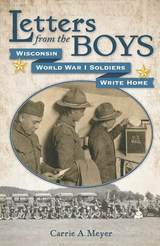 Letters from the Boys: Wisconsin World War I Soldiers Write Home
Carrie A Meyer
Wisconsin Historical Society Press, 2018 Words from the Wisconsin boys manning the trenches.
On the 100th anniversary of the arrival of the flood of American troops in Europe that would shift the tide of World War I in favor of the Allies, Letters from the Boys brings to life this terrible war as experienced by Wisconsinites writing home.
Technology had transformed the battlefield in alarming ways. Automatic rifles mowed down the young men who went “over the top” to attack enemy trenches; airplanes and improved artillery brought death unseen from miles away; terrifying clouds of poison gas choked and burned the European countryside; the internal combustion engine brought tanks to the battlefield for the first time and revolutionized the way troops deployed.
In the thick of it were young men from Wisconsin who found themselves caught up in geopolitical events half a world away. Professor Carrie A. Meyer combed through three newspapers in Green County, Wisconsin, to collect and synthesize the letters from the boys into a narrative that is both unique and representative, telling the stories of several Green County boys and what they saw, from preparing for war, to life among French families near the front, to the terror of the battlefield. Meyer gracefully removes the veil of obscurity and anonymity hanging over soldiers who participated in a war fought so long ago by great numbers of men, reminding us that armies are made of individuals who strove to do their part and then return to their families.
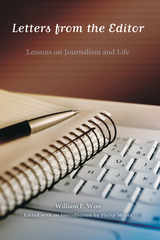 Letters from the Editor: Lessons on Journalism and Life
William F. Woo & Philip Meyer
University of Missouri Press, 2007 William F. Woo, born in China, was the first person outside the Pulitzer family to edit the St. Louis Post-Dispatch and the first Asian American to edit a major American newspaper. After forty years in the newsroom, Woo embarked on a second career in 1996 teaching journalism at Stanford University, where he wrote weekly informal essays to his students in the same personal style that characterized his columns for the Post-Dispatch. Each made a philosophical point about journalism and society and their delicate relationship over the last half of the twentieth century. Woo was revered as both a writer and a reporter, and this volume collects some of the best of those essays to the next generation of journalists on their craft’s high purpose. As inspiration for students from someone who knew the ropes, it distills the essence of the values that define independent journalism while offering them invaluable food for thought about their future professions. The essays touch on a wide range of subjects. Woo reflects on journalism as a public trust, requiring the publication of stories that give readers a better understanding of society and equip them to change it for the better. He also ponders print journalism conducted in the face of broadcast and online competition along with the transformation of newspapers from privately owned to publicly traded companies. Here too are personal reflections on the Pulitzer family’s impact on journalism and on the tensions between a journalist’s personal and professional life, as well as the conflicts posed by political advocacy versus free speech or a reporter’s expertise versus a newspaper’s credibility. Woo’s idealistic spirit conveys the virtues of his era’s newspaper journalism to the next generation of journalists—and most likely to the next generation of news media as well. Even as new students of journalism have an eye on an electronic future, Woo’s essays come straight from a newsman’s heart and soul to remind them of values worth preserving.
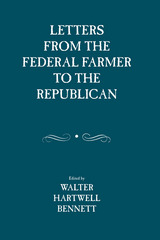 Letters from the Federal Farmer to the Republican
Walter Bennett
University of Alabama Press, 1978 The Federal Farmer’s letters were written in opposition to the Constitution in the form in which it had come from the Federal Convention of 1787. Their immediate objective was to secure amendments to the Constitution before it was ratified by state convention. But the letters are valuable also for the basic political philosophy that they represent, specifically, the political philosophy of the revolution and the Bill of Rights. This philosophy stresses principles of federalism and republicanism and exemplifies the liberal idealism that took root in America during the Revolutionary War era. As first published, the letters comprised two separate pamphlets, one appearing in the fall of 1787 and consisting of five letters, the other appearing in the spring of 1788 and consisting of thirteen letters. The letters have seldom been reprinted, and until now they have never been issued together in a single edition. One of the merits of the present volume is that it includes all the letters exactly as they appeared in the original printed texts. A synoptic table of contents for the entire series has been supplied by the editor, in addition to an editor’s introduction, which includes a critical analysis of the Federal Farmer’s main arguments and also deals with the authorship of the letters. Richard Henry Lee of Virginia was early identified as the author of the letters, and in the course of the nineteenth century this attribution came to be generally accepted. However, Lee gave no hint in his known writings that he had written the letters, and in recent years the attribution of authorship to him has been questioned by competent scholars. The editor makes clear that he considers the evidence supporting the attribution to Lee to be strong, but he concludes, on the basis of his own investigation, that the question of authorship should not at this point be considered to have been settled. He makes no assumption that the matter will eventually be settled but suggests that a thoroughgoing linguistic and comparative analysis of Lee’s known writings and the Federal Farmer’s letters should be helpful in considering the question further. The letters have long been considered to be among the most significant of the political literature published in America during the great debate over the ratification of the Constitution. Alexander Hamilton refers to the Federal Farmer in the sixty-eight essay of The Federalist as “the most plausible” of the opponents of the Constitution to have appeared in print. Recent scholars probing into the literature of these so-called antifederalists have indicated that they have been quite impressed by the general content and comparatively moderate tone of the Federal Farmer’s letters, and also by the seemingly substantial influence that the letters had in articulating arguments that appeared sooner or later in other writings against ratifying the Constitution in it original form.
Letters from the Front, 1898-1945
Michael E. Stevens
Wisconsin Historical Society Press, 1992 This volume tells the stories of 62 men and women from Wisconsin who served in the Spanish-American War, World War I, and World War II. Letters from the Front is a vivid social history of wartime as told by those who took part in these foreign conflicts. Most of them are "ordinary" people, uprooted from farms, factories, and offices, who took part in extraordinary events. This work explores how war changed their lives and reveals the emotions they felt in uniform, in remote outposts, in combat, and in prison camps. These letters, diaries, oral histories, newspapers, and contemporary accounts provide a history of adaptation to military life; they also reflect the changes that occurred over the half-century encompassing these confilcts, an era of great technological innovation — and one in which America's vision of itself also changed.
Letters from the Headwaters
Aaron Abeyta
University Press of Colorado, 2014 Through epistolary essays and poems, American Book Award- and Colorado Book Award-winning author and poet Aaron A. Abeyta captures the soul of the cultural and geographical crossroads of the driest quadrant in the nation, the Colorado headwaters, source to all the rivers in the southwestern and mid-western United States. Originating from and expanding on the themes of twenty-five years of “Headwaters” conferences at Western State Colorado University, these essays and poems embrace the region’s past while also exploring the struggles of a present that seeks a sustainable future for the borderlands that define the very cross-cultural essence of the American experience.
Letters From The Promised Land: Swedes in America, 1840-1914
H. Arnold Barton
University of Minnesota Press, 2000 Swedish immigrants tell their own stories in this collection of letters, diaries, and memoirs—a perfect book for those interested in history, immigration, or just the daily lives of early Swedish-American settlers.
|
|
